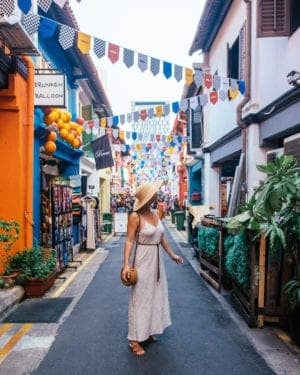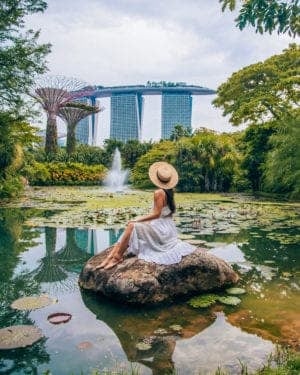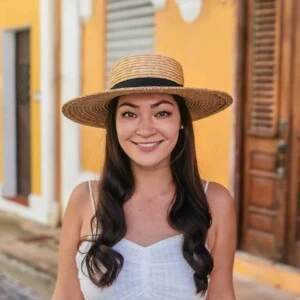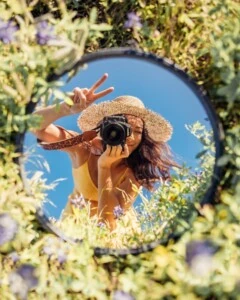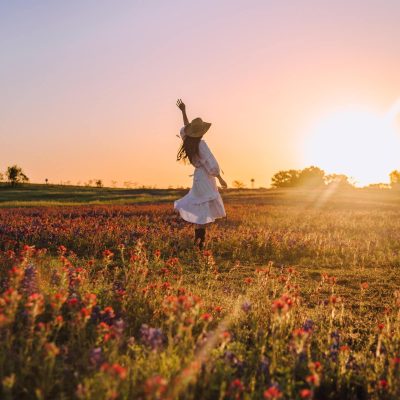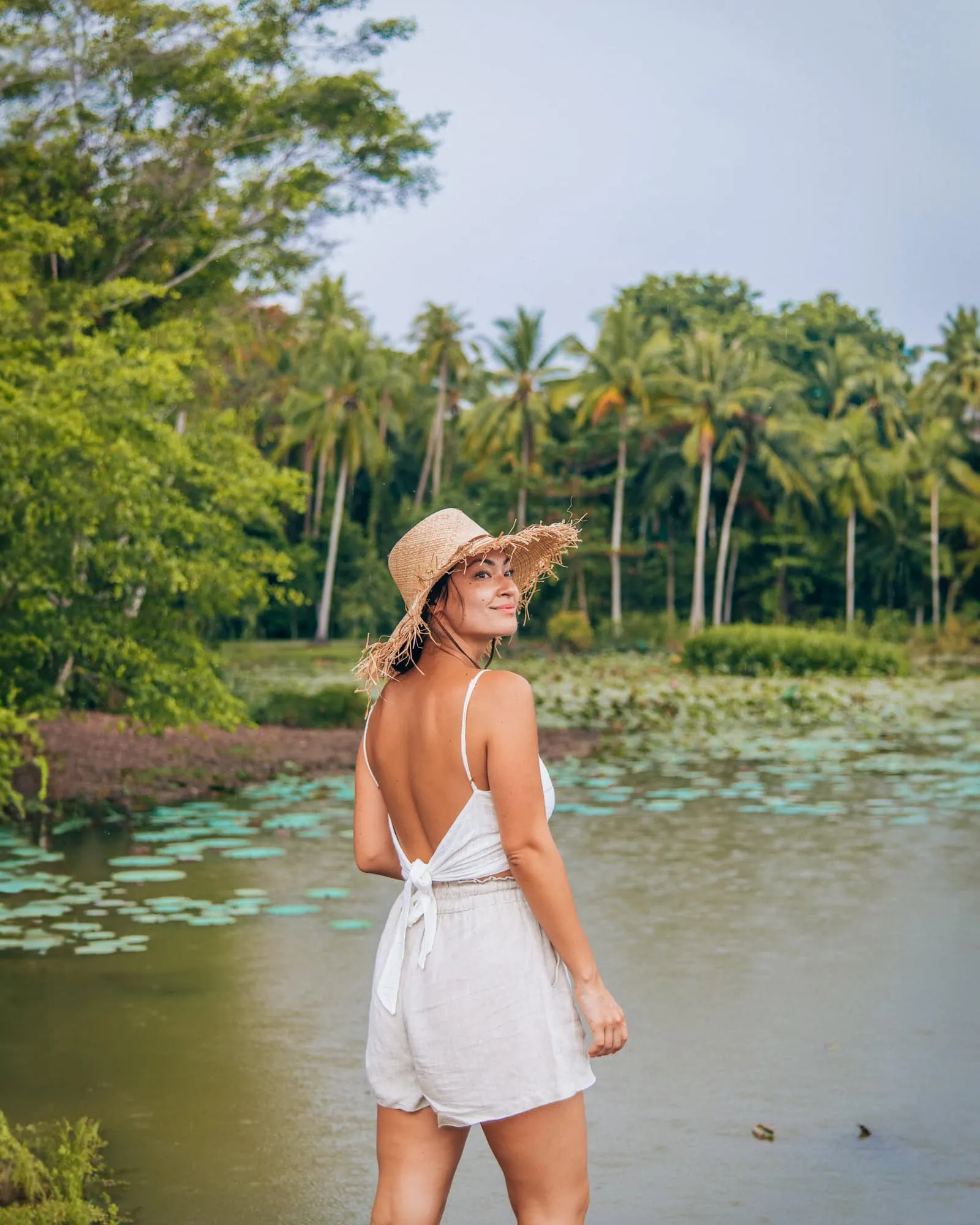
If you’re looking for a fun and adventurous day trip from Singapore, you should definitely check out Pulau Ubin, a rustic island home to diverse wildlife, scenic trails, and cultural attractions that will make you feel like you’ve traveled back in time.
Every time I visit Singapore, I make a point to visit this island to get a taste of Singapore’s past. You’ll feel like you are no longer in modern Singapore! It’s truly one of the best things to do in Singapore if you ask me! (See what else I think is a MUST DO in Singapore here!)
So, how do you get to Pulau Ubin? And what are the best things to do in Pulau Ubin? Let’s get to it!
What is Pulau Ubin?
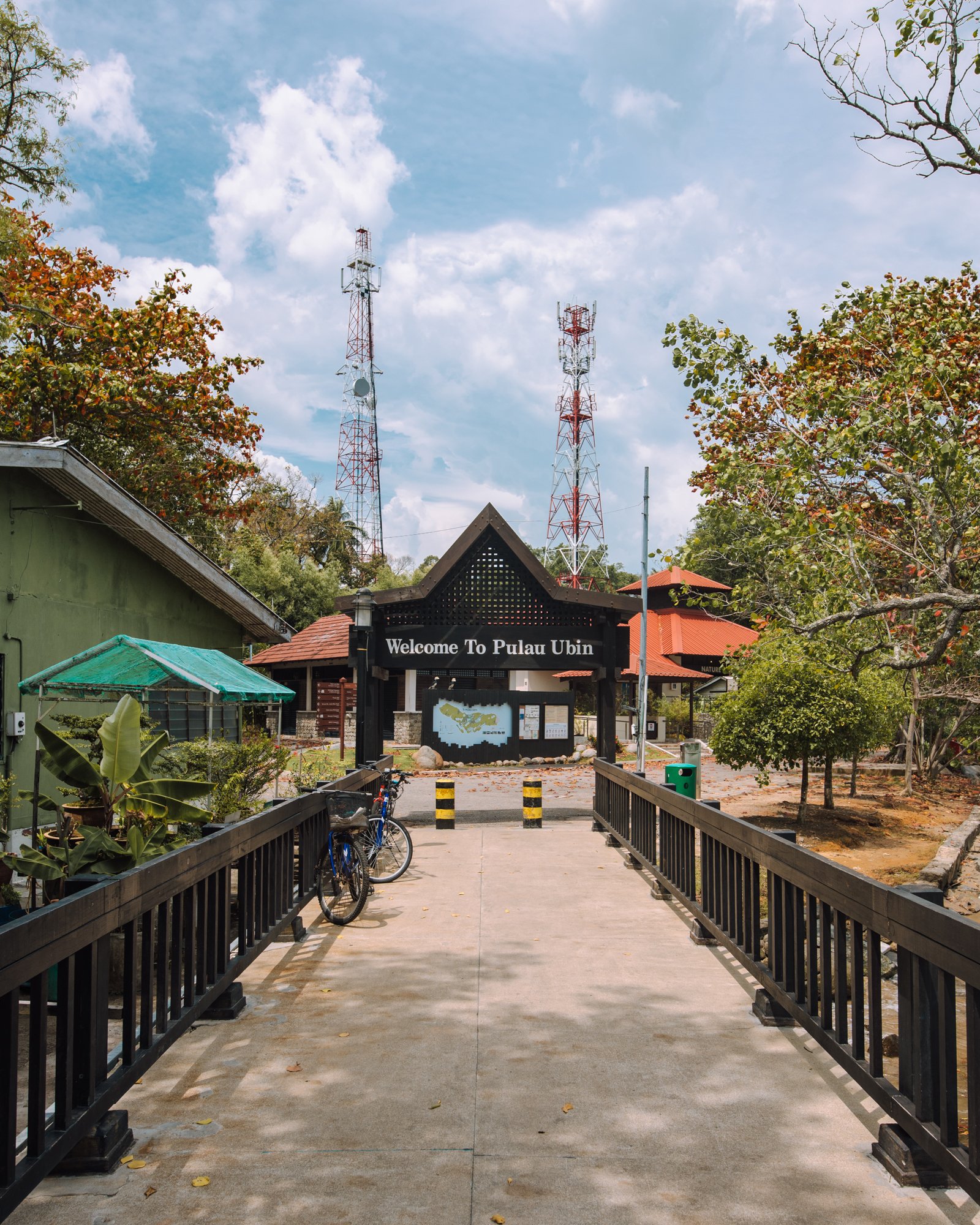
If you’re not familiar with Pulau Ubin, let me do a brief intro to Ubin island.
Pulau Ubin is an island off the northeast coast of Singapore, where you can experience the charm of a traditional village and the natural beauty of a tropical forest. It’s the perfect destination to escape the hustle and bustle of the city!
Pulau Ubin is known for its rich history, culture, outdoor activities, and wildlife.
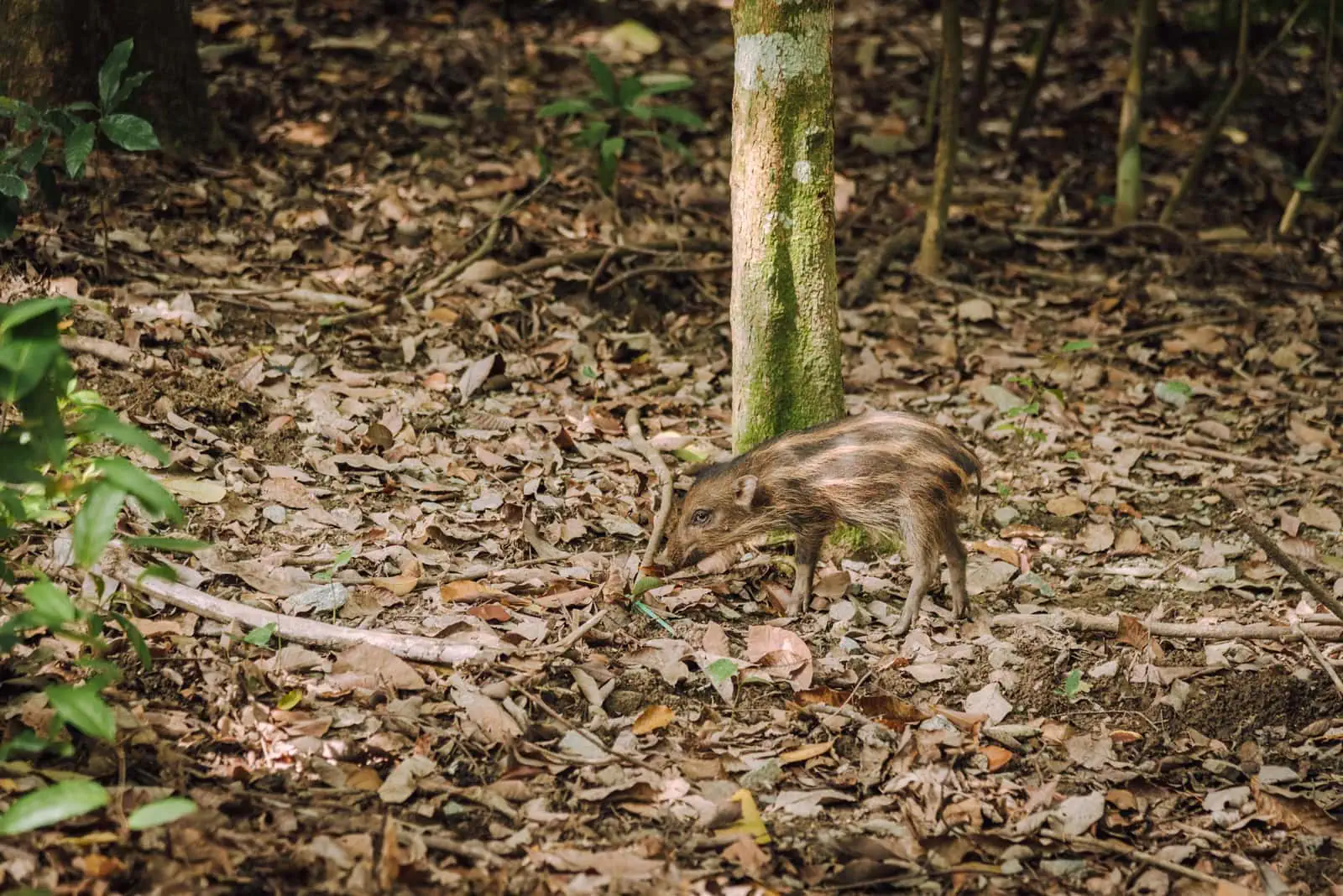
Pulau Ubin means “Granite Island” in Malay, as it was once a source of granite for building projects in Singapore and Malaysia.
While granite mining stopped in the 1960s, you can still see the remnants of the old quarries, some of which have been transformed into scenic lakes!
Is Pulau Ubin worth visiting?
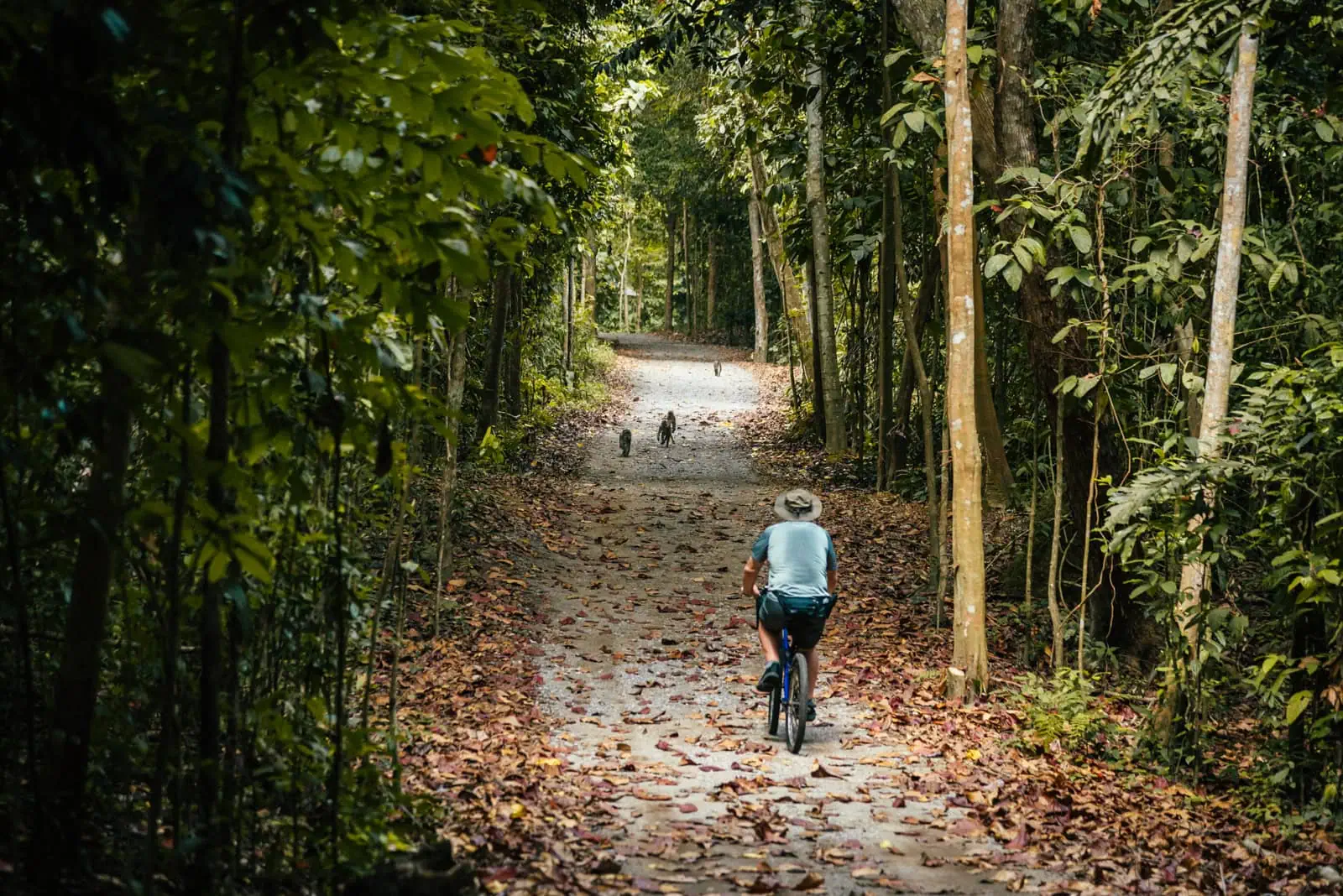
Pulau Ubin is worth visiting because it offers something for all visitors, whether you are a nature lover, a history buff, or an adventure seeker.
You can explore the island by bike, kayak, or on foot, and discover its many attractions, which I’ll cover in just a bit. You can also enjoy the local cuisine at the various eateries and kiosks and mingle with the friendly residents who still live in traditional wooden houses.
Rent a bicycle and explore the island’s trails, villages, and ecosystems.
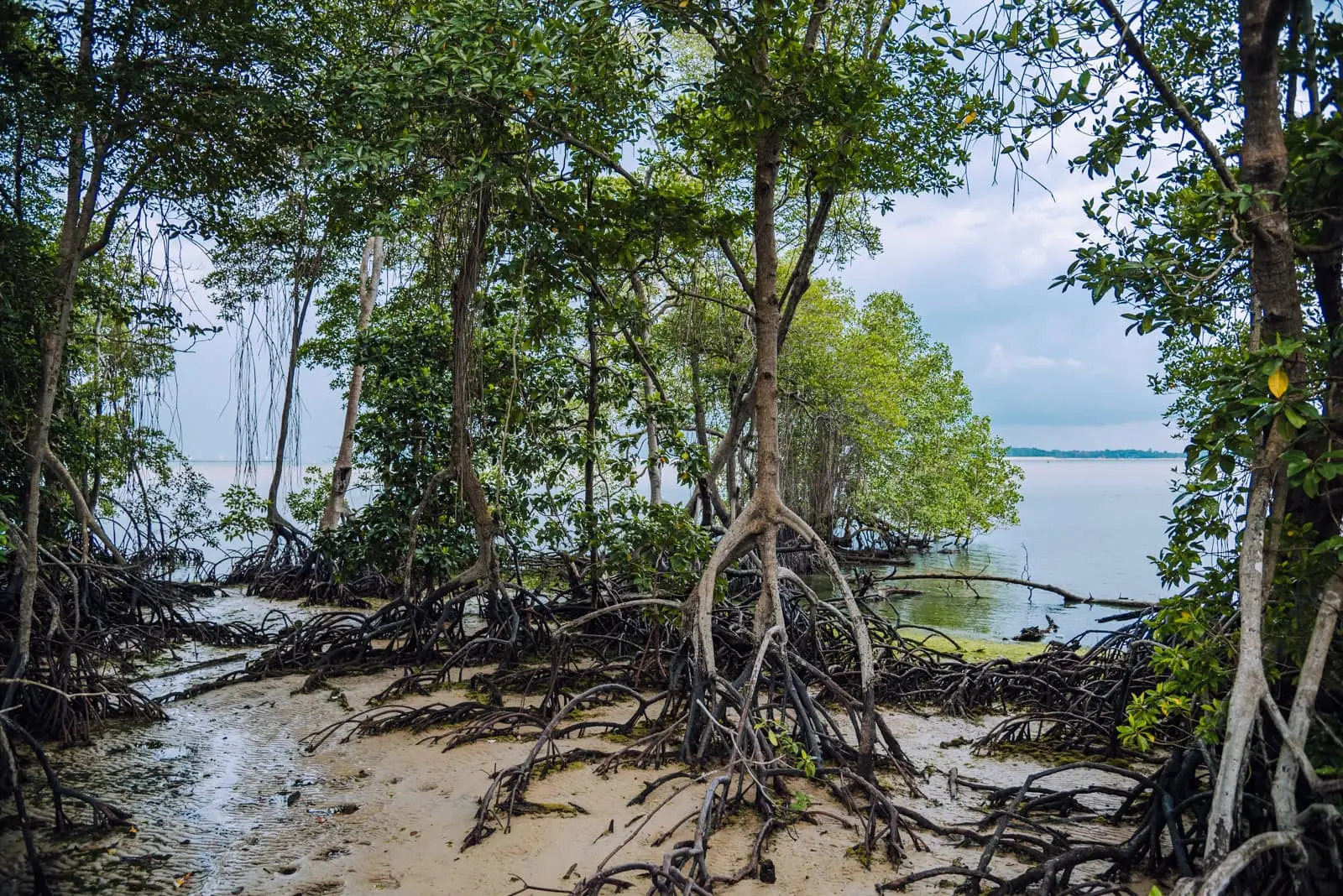
Cycling is the best way to get around the island and see its diverse landscapes, like mangrove forests, wetlands, and quarries. It’s uniquely beautiful (and one of my favorite Instagrammable spots in Singapore!).
Here’s how to get to Pulau Ubin and what to do when you’re on the island.
How to Get to Pulau Ubin
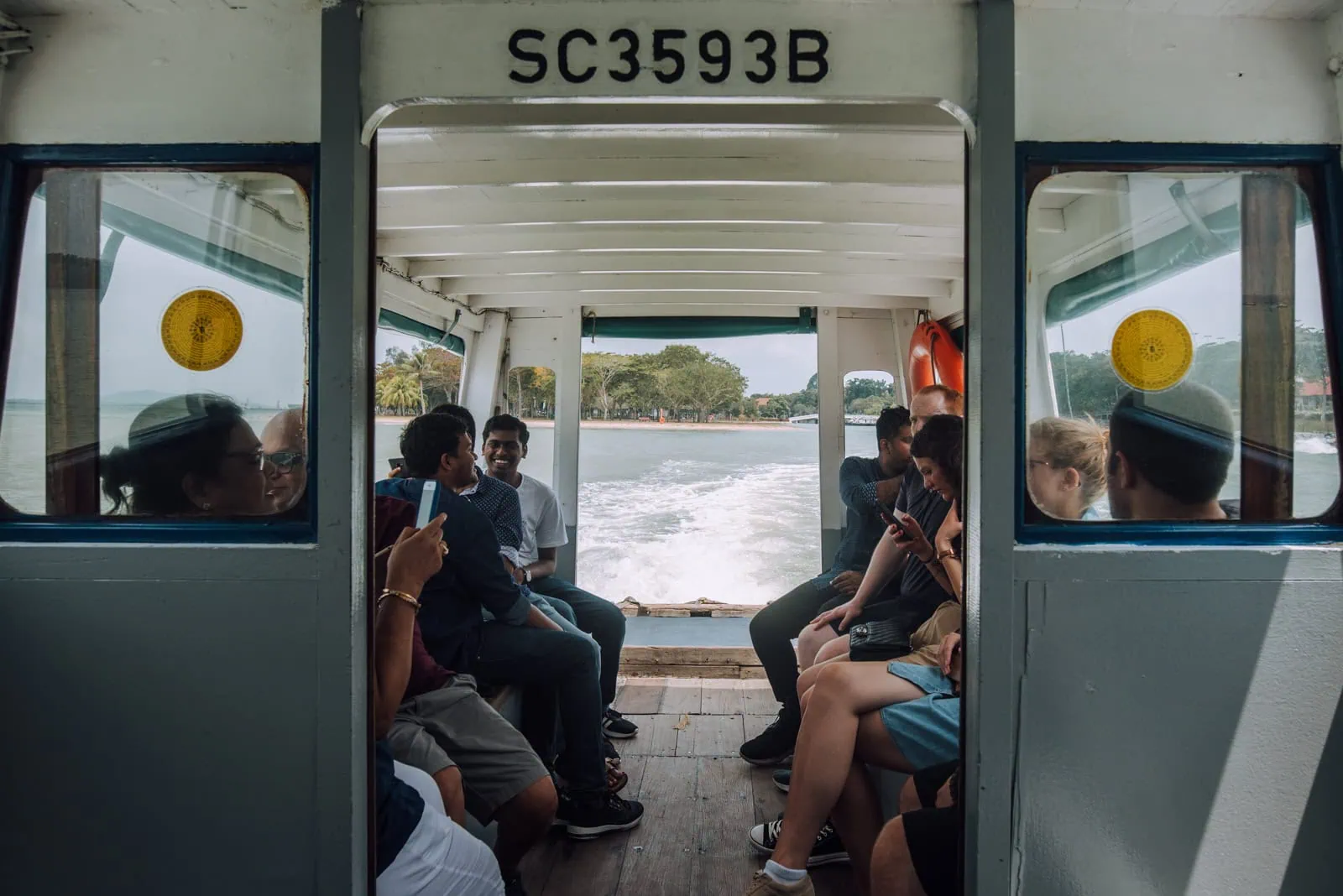
So, how do you get to Pulau Ubin island?
Well, fortunately, getting to Pulau Ubin is pretty cheap and easy!
All you need to do is take a bumboat from Changi Point Ferry Terminal, which is located near Changi Village. You can get there by taking the subway to Pasir Ris station, then taking bus 109 to Changi Village Terminal.
From there, it’s a short walk to the ferry terminal, where you’ll find two areas: one for boats to Pulau Ubin, and another for boats to Penggerang, Johor. Make sure you join the right line!
The bumboats run from 6am to 7pm daily, and they don’t have a fixed schedule. They leave whenever there are 9 to 12 passengers on board, which usually doesn’t take long.
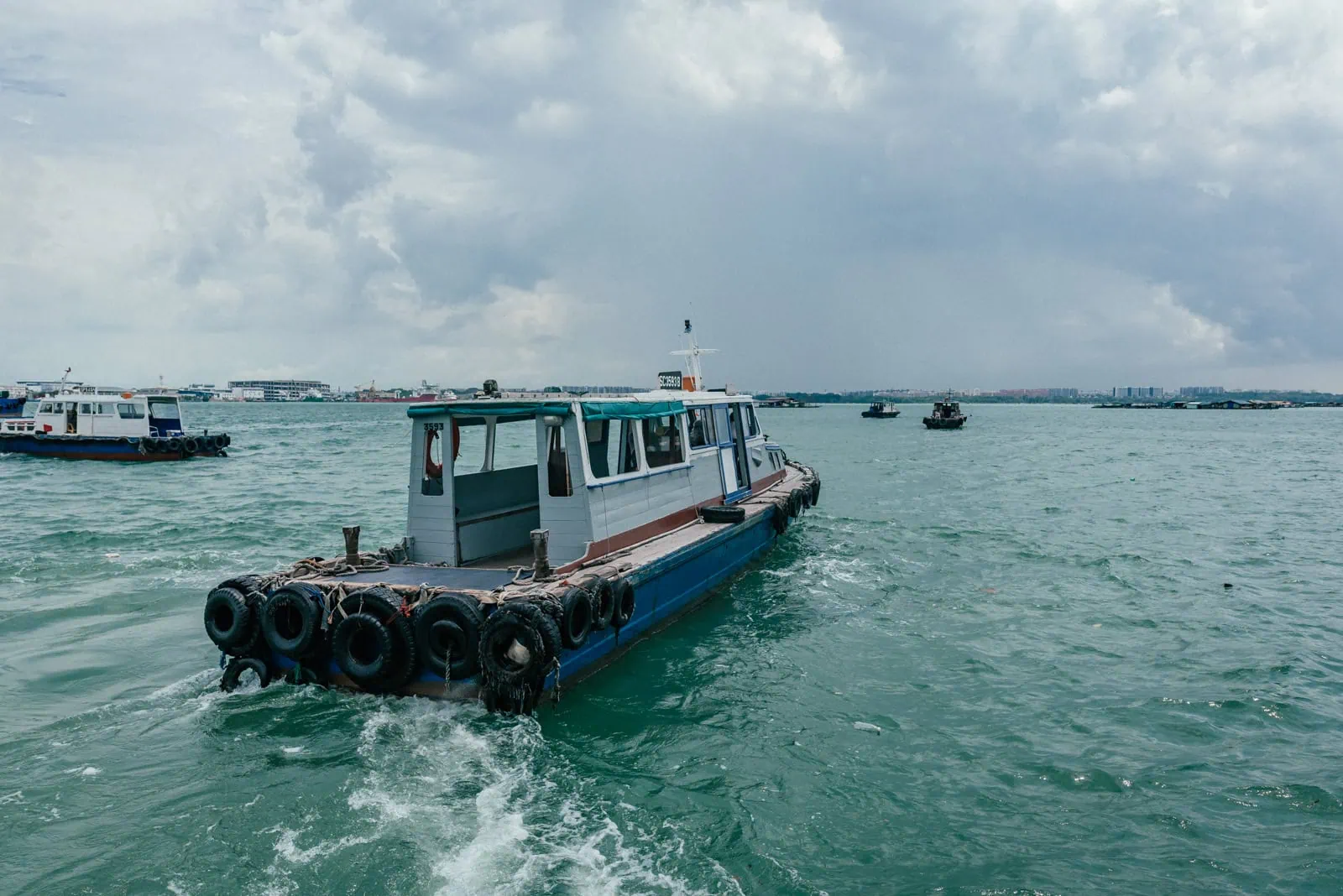
The boat ride costs S$4 per person per trip, and you pay the boat operator directly in cash. (So make sure you have at least S$8 for the round trip bumboat ride.) And if you’re bringing your own bicycle, you’ll have to pay a S$3 surcharge.
Tips for your return journey: Though the bumboats are supposed to run from 6am to 7pm, Singapore’s NParks recommends making arrangements directly with the bumboat driver if you plan to leave after 6pm. They also say to call the NParks hotline at 1800-471 7300 if there aren’t any bumboats available at the main jetty for your return trip!
The boat ride takes about 15 minutes, and you’ll enjoy the views of the water and the mangroves along the way.
Once you arrive at Pulau Ubin Jetty, you’ll be greeted by a sign that says “Welcome to Pulau Ubin”.
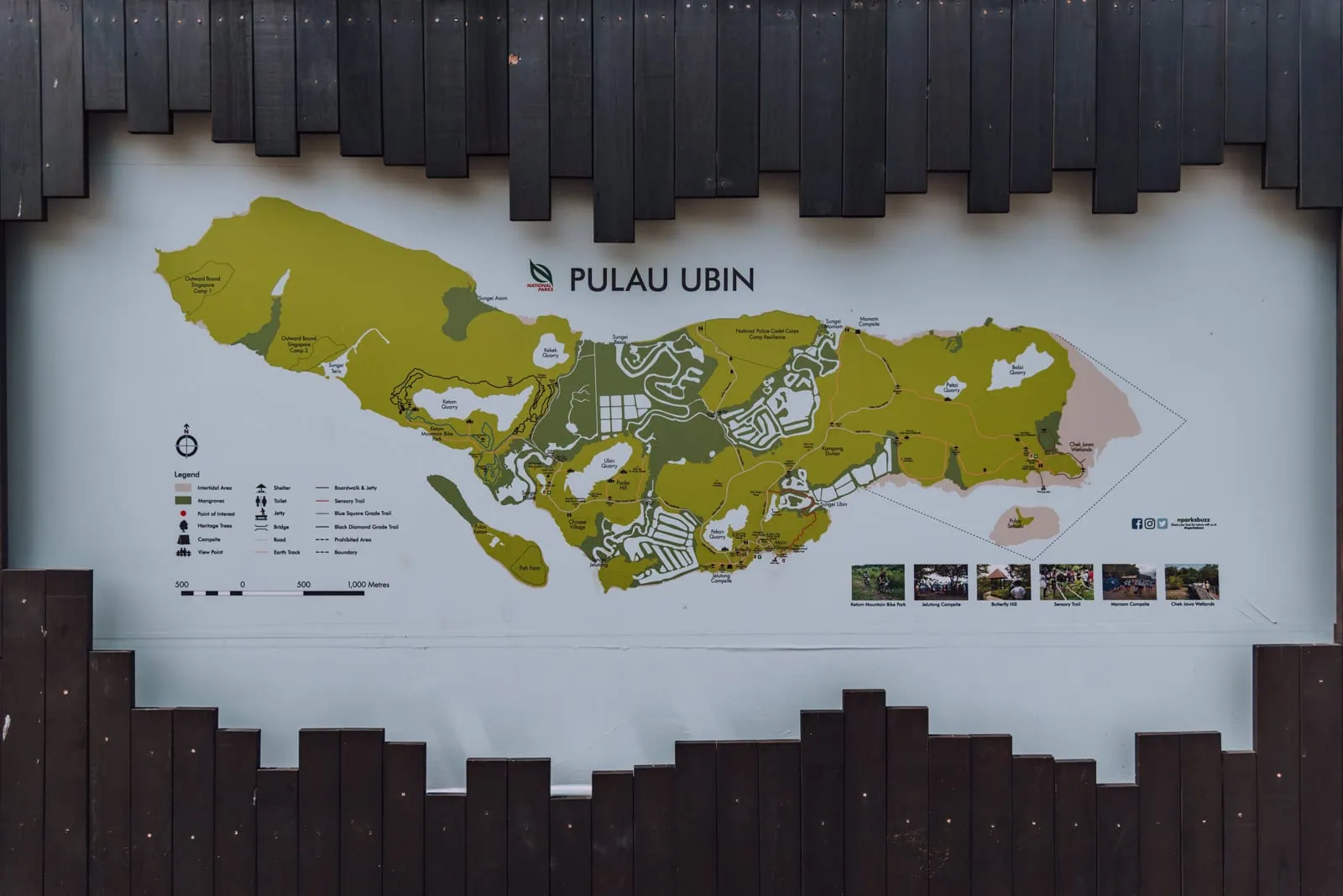
You’ll also see this map of the island and can go out and explore from there!
Next, let’s get into the logistics of how to get around Pulau Ubin:
How to Get Around Pulau Ubin
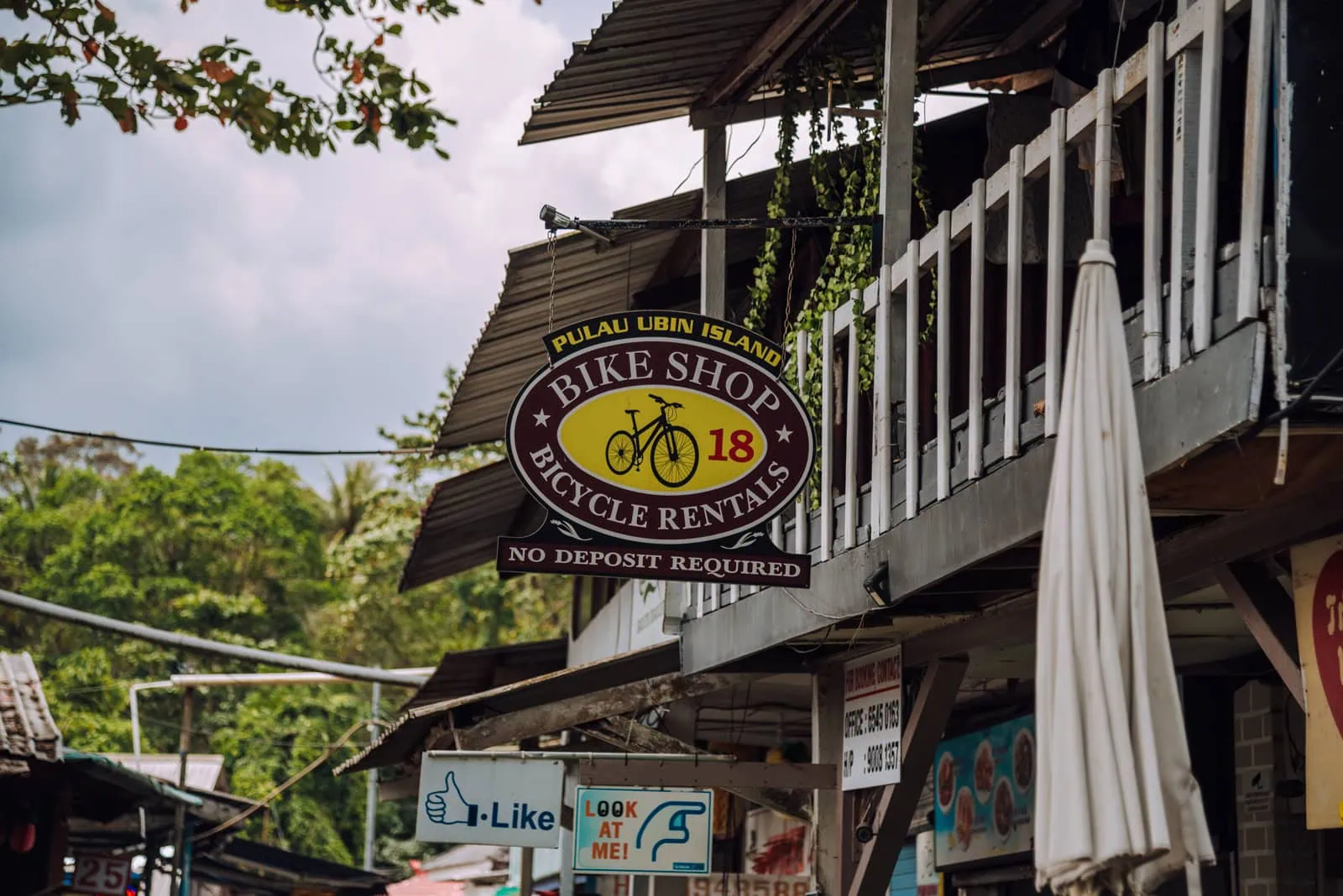
As soon as you arrive at Pulau Ubin, you’ll see a bunch of different bicycle rental shops.
Renting a bicycle is the best way to explore the island, as it allows you to cover more ground and access more places. There are many flat bike trails that are easy to cycle on.
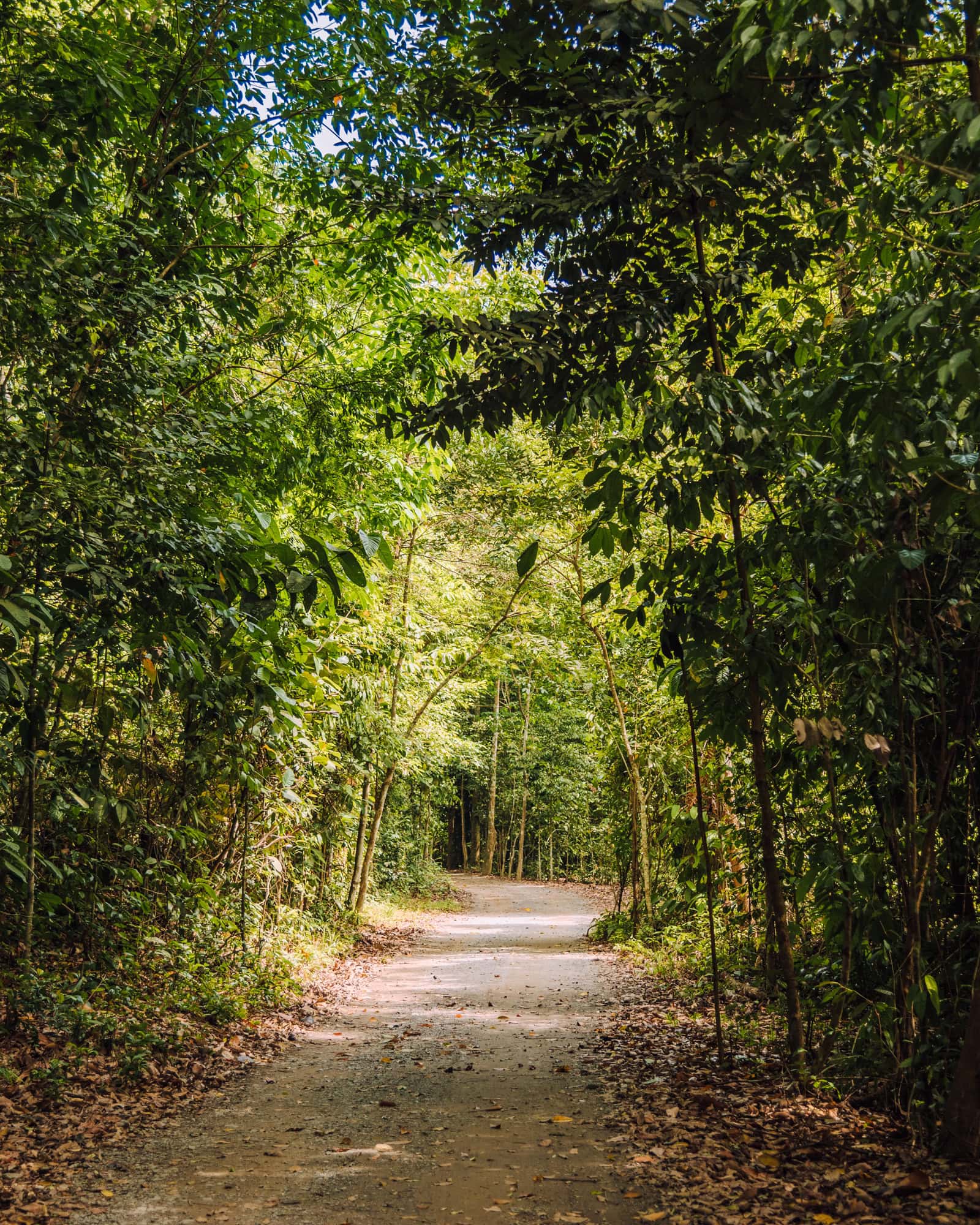
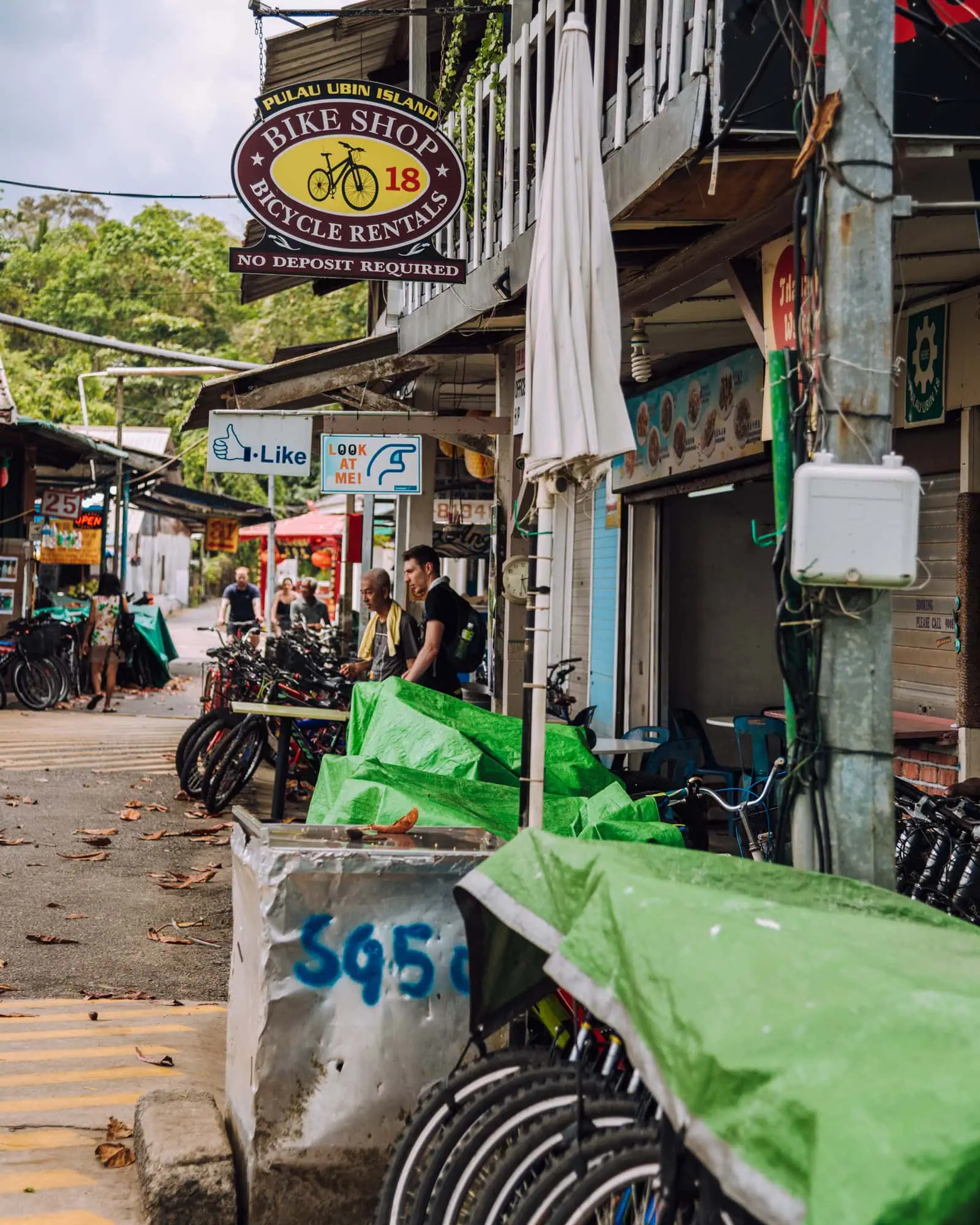
You can choose from different types of bicycles, depending on your preference and skill level. The rental fee varies but a typical cost is around S$15 for a full day and typically includes a helmet and a free bottle of water.
Renting a bike from the shops near the jetty and cycling along the trails that crisscross the island is truly the best way to explore it.
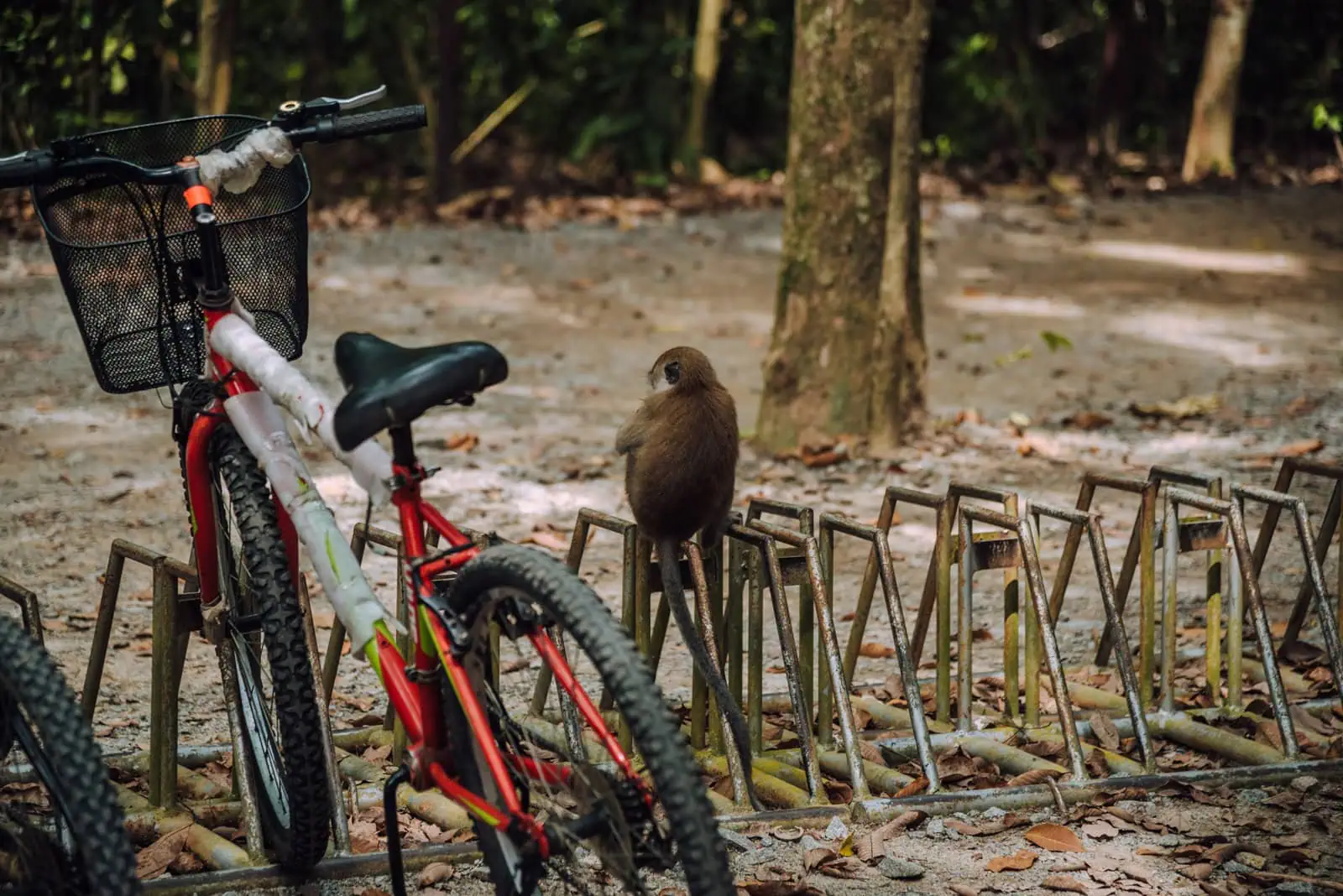
But if you prefer to walk, you can follow the nature trails that lead you to various attractions, such as the Sensory Trail, Butterfly Hill, and Pekan Quarry. Keep in mind that you’ll need to allow enough time to walk back to the jetty before the last bumboat leaves at 7pm!
Go kayaking or canoeing along the island’s coast and discover its hidden gems, such as secluded beaches, caves, and coves. For S$98 per person, you can paddle through the mangroves (minimum of 2 people per booking) and see the diverse flora and fauna that thrive in this habitat.
You have so many options to explore (for a range of budgets)- there are private boat tours, guided kayak fishing tours, catamaran tours, and more! Kayaking and canoeing are great ways to enjoy the island’s scenery and tranquility, as well as to get some exercise.
Lastly, there are taxi services at the main jetty, which start at S$12. Taxi drivers often live on the island and are a treasure trove of information about it! However, you’ll need to make arrangements with your taxi driver if you want to get out and walk around.
Now that you know how to get around Pulau Ubin, you’re ready to discover the best things to do on Pulau Ubin!
Here are some of the highlights that you shouldn’t miss:
Best Things to Do on Pulau Ubin
Here are some of the best places to explore and things to do on Pulau Ubin:
Chek Jawa Wetlands
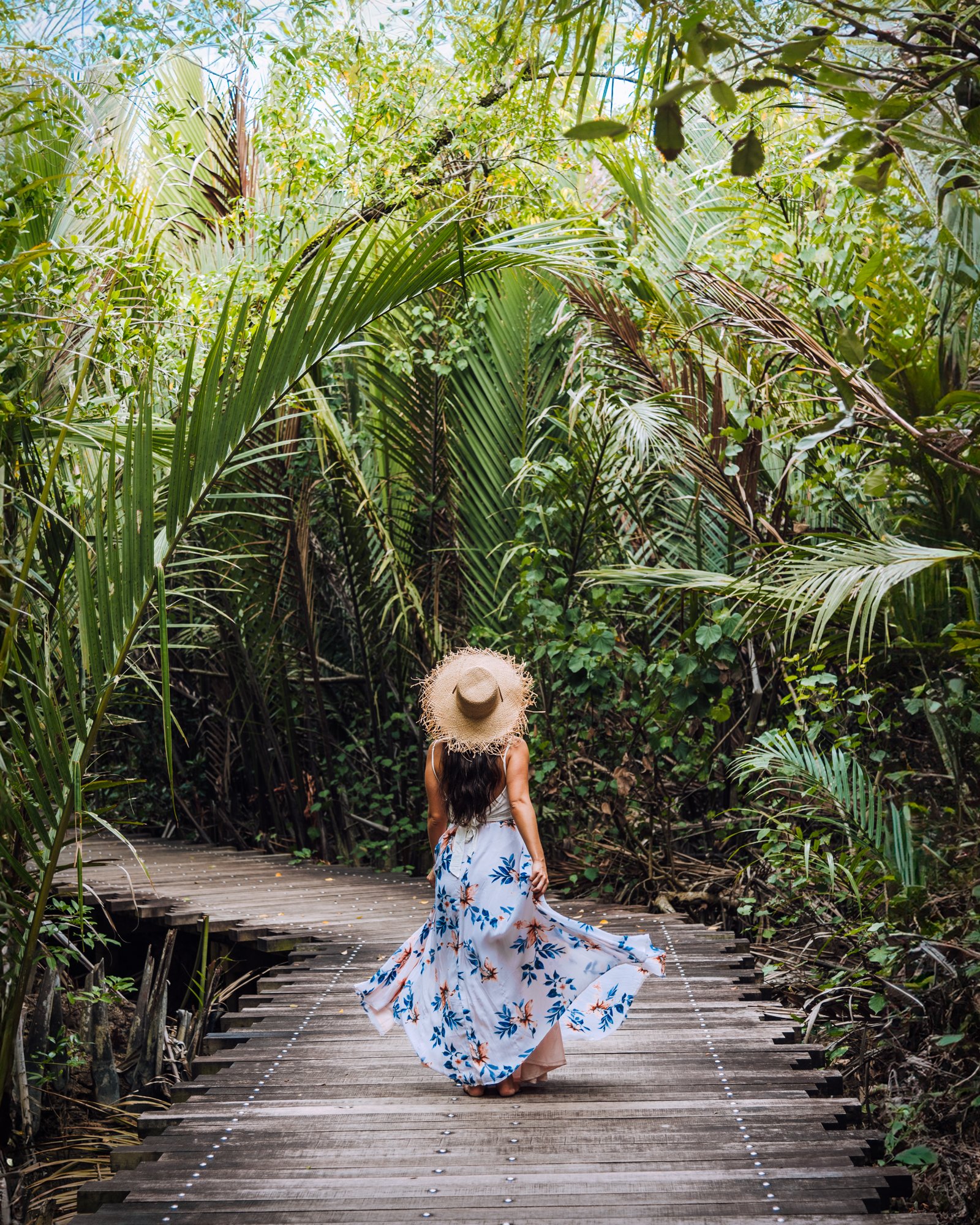
I always visit the wetlands each time I visit Pulau Ubin!
This is one of the most popular attractions on Pulau Ubin, and for good reason.
Chek Jawa is a rich ecosystem that hosts a variety of marine life, such as starfish, crabs, sea cucumbers, and corals. As you explore the coastal forests, mangrove swamps, and walk along the shore, you might also spot mudskippers, red junglefowl, wild boar, hornbills, and monitor lizards!
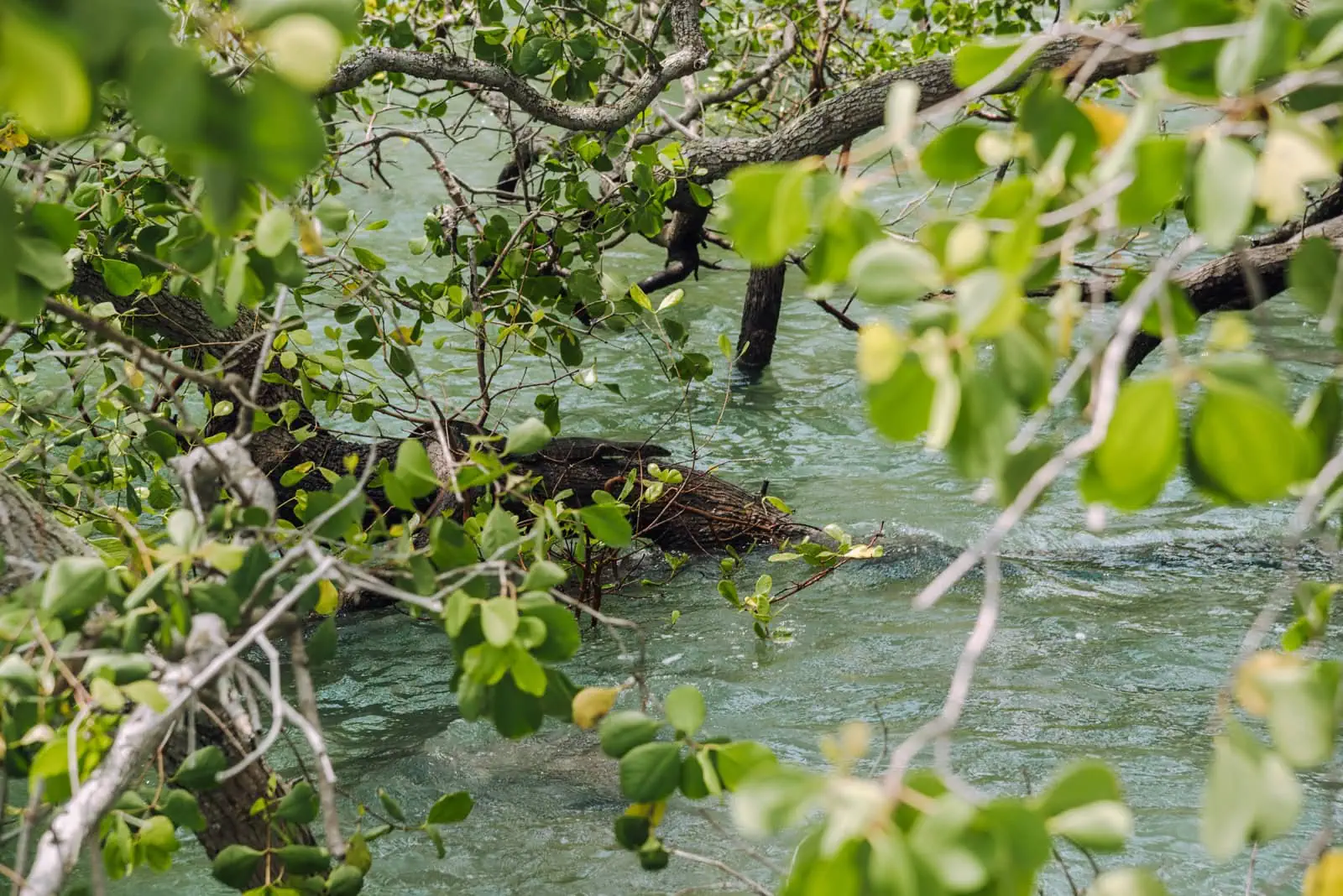
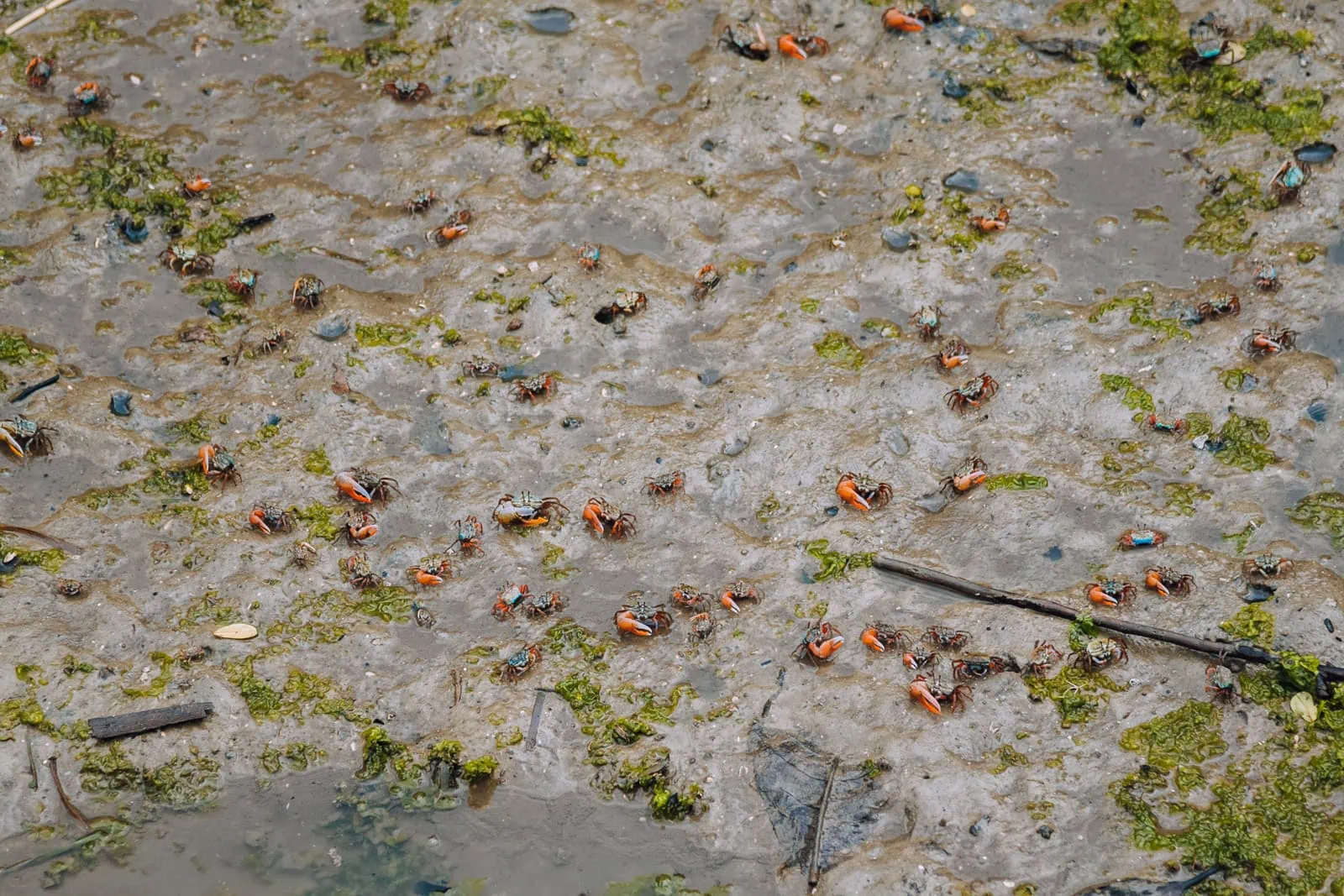
You’ll find six major ecosystems here: mangroves, coastal forest, seagrass lagoon, coral rubble, rocky beach, and sandy beach (not for swimming, though!).
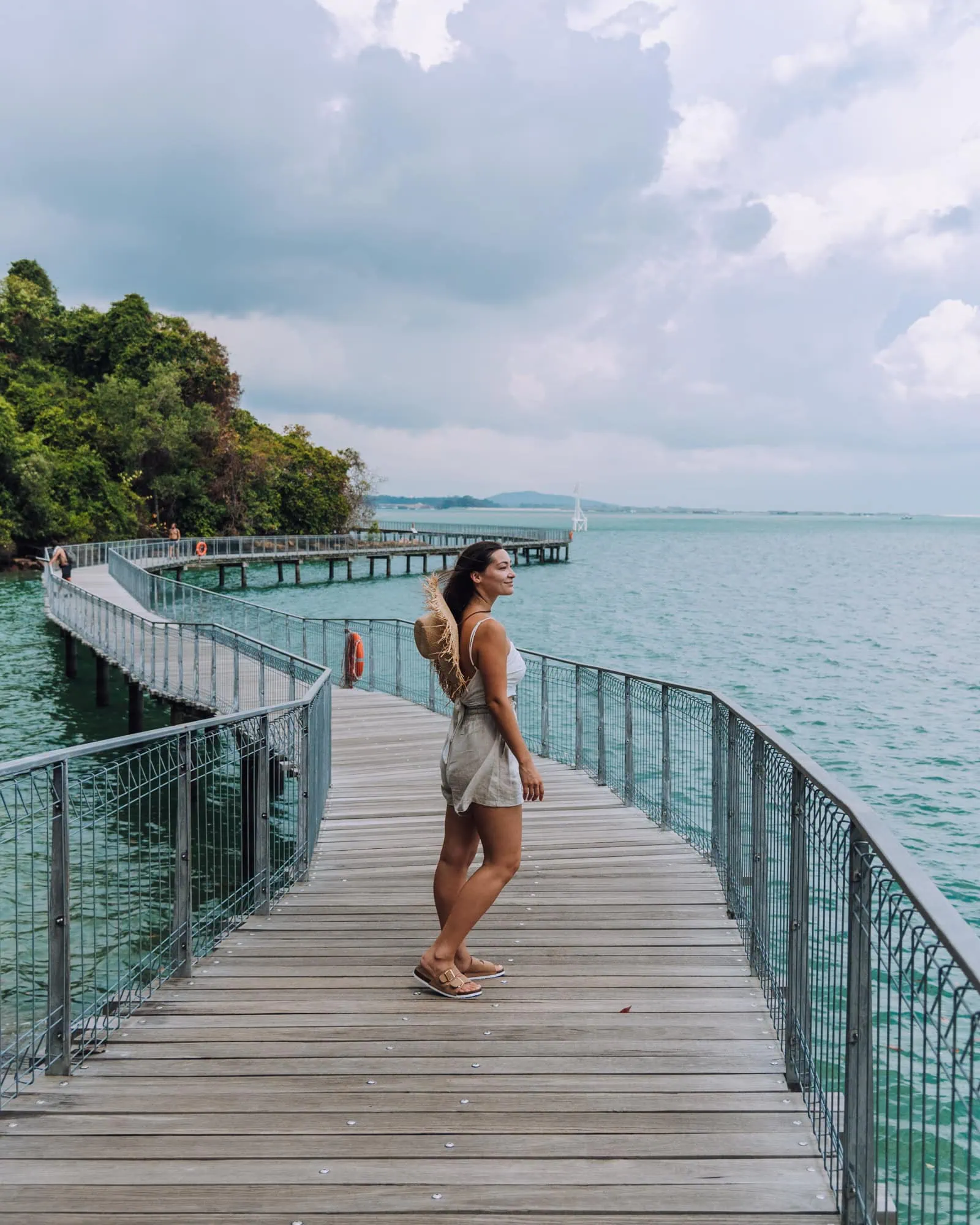

You can walk along the boardwalks and observe the wildlife from above, or join a guided tour for S$60 per person to learn more about the ecology and conservation of the wetlands and explore the intertidal zone during low tide.
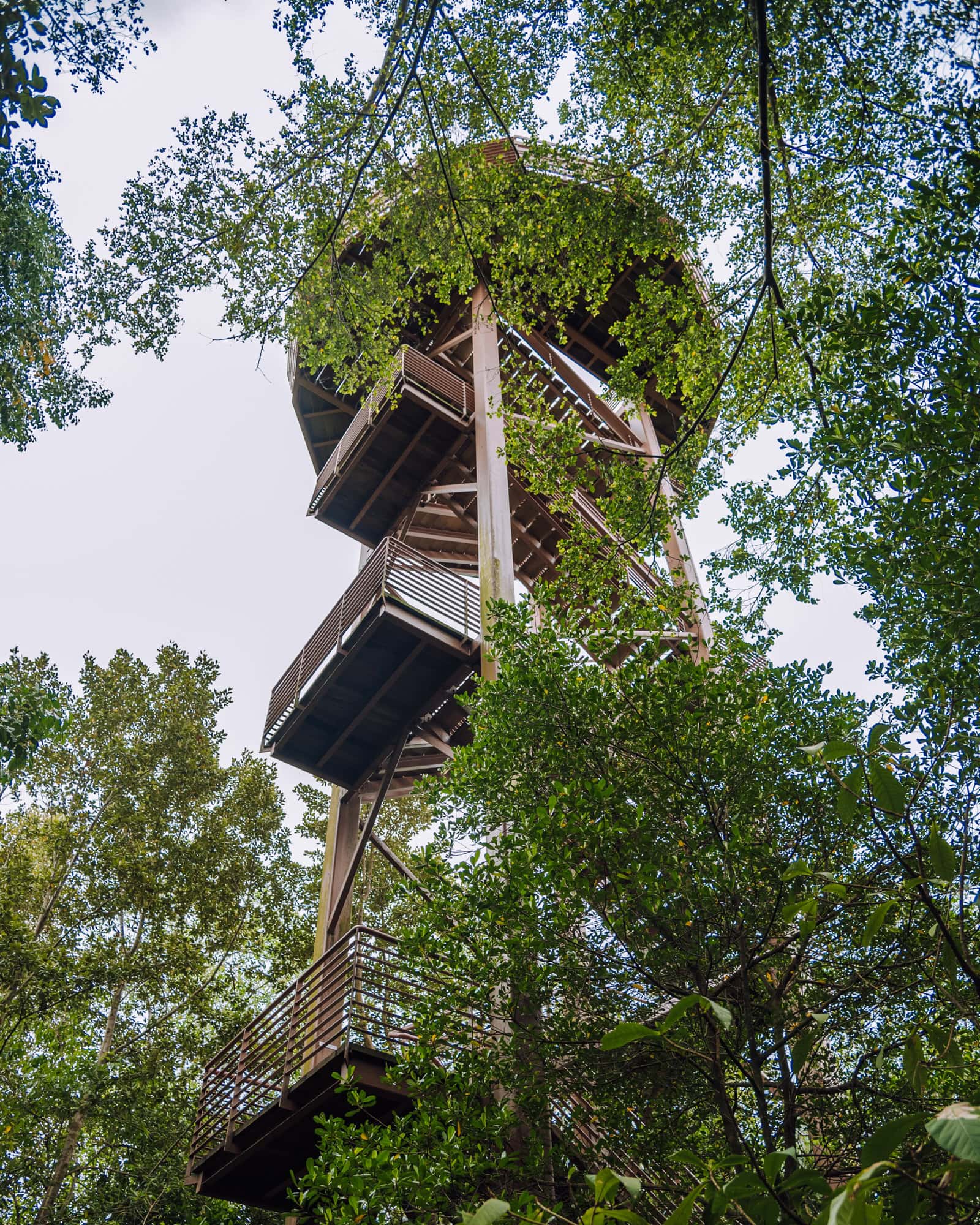
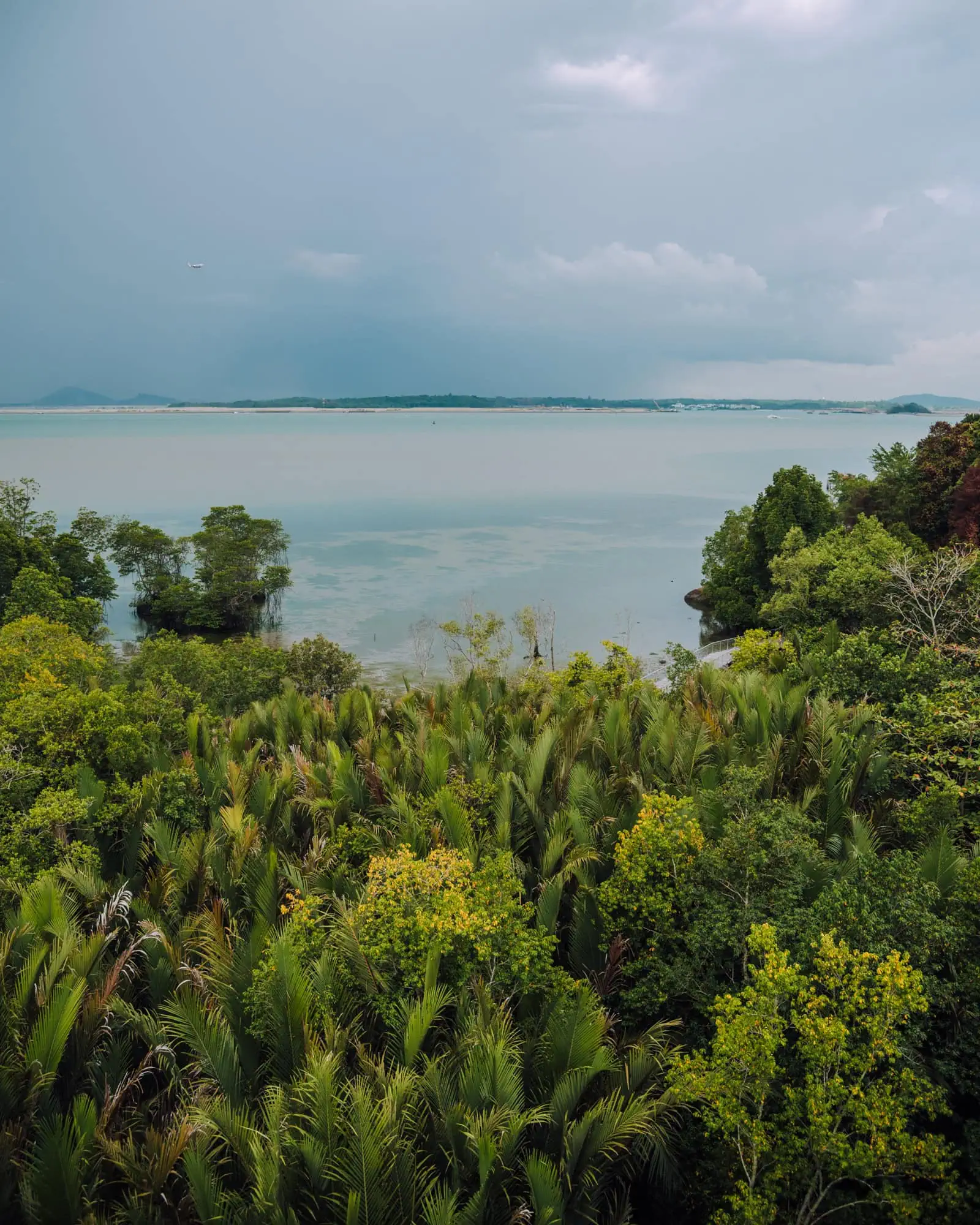
While here, you should also go up the Jejawi Tower, which offers a panoramic view of the wetlands and the surrounding islands.
Ubin Fruit Orchard
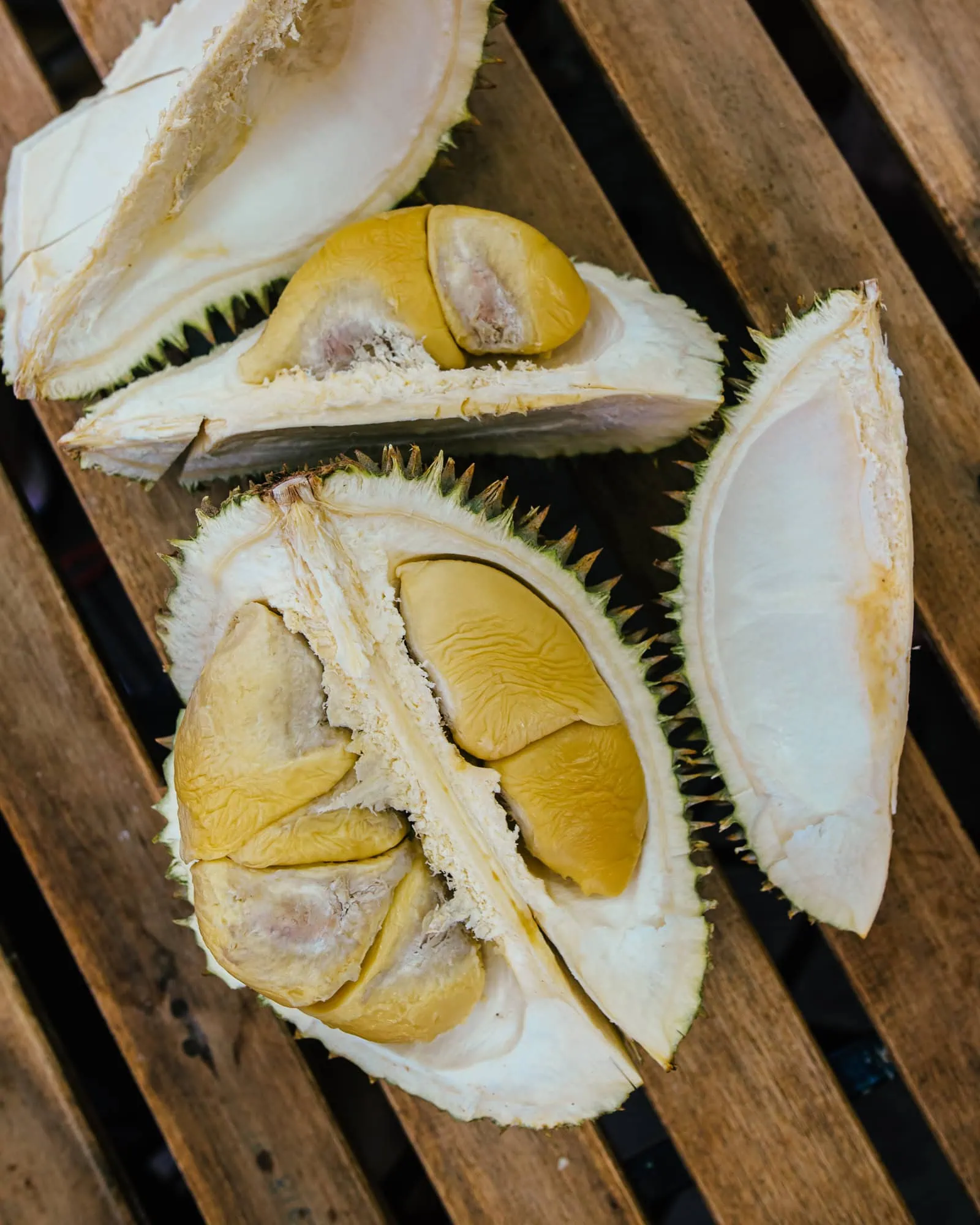
Take a visit to the Ubin Fruit Orchard, where you can see over 350 fruit trees, including durians, mangosteens, and breadfruits.
This community project aims to preserve and promote the island’s fruit heritage. There are over 30 types of tropical fruits here, such as rambutan, jackfruit, and cempedak, growing in the orchard. Learn about their uses and benefits, and about the habitat restoration efforts on the 2-hour Rustic Reflections Tour for S$60 per person. You can even taste some of the fruits when they are in season!
Ketam Mountain Bike Park
If you’re feeling adventurous, head to Ketam Mountain Bike Park. Here you’ll find 10km (around 6.2 miles) of challenging trails around Ketam Quarry with different difficulty levels.
You’ll encounter steep slopes, sharp turns, rocky terrain, and wooden bridges as you ride through the forest. Be prepared to sweat and get dirty, but also to have lots of fun!
Pulau Ubin Sensory Trail
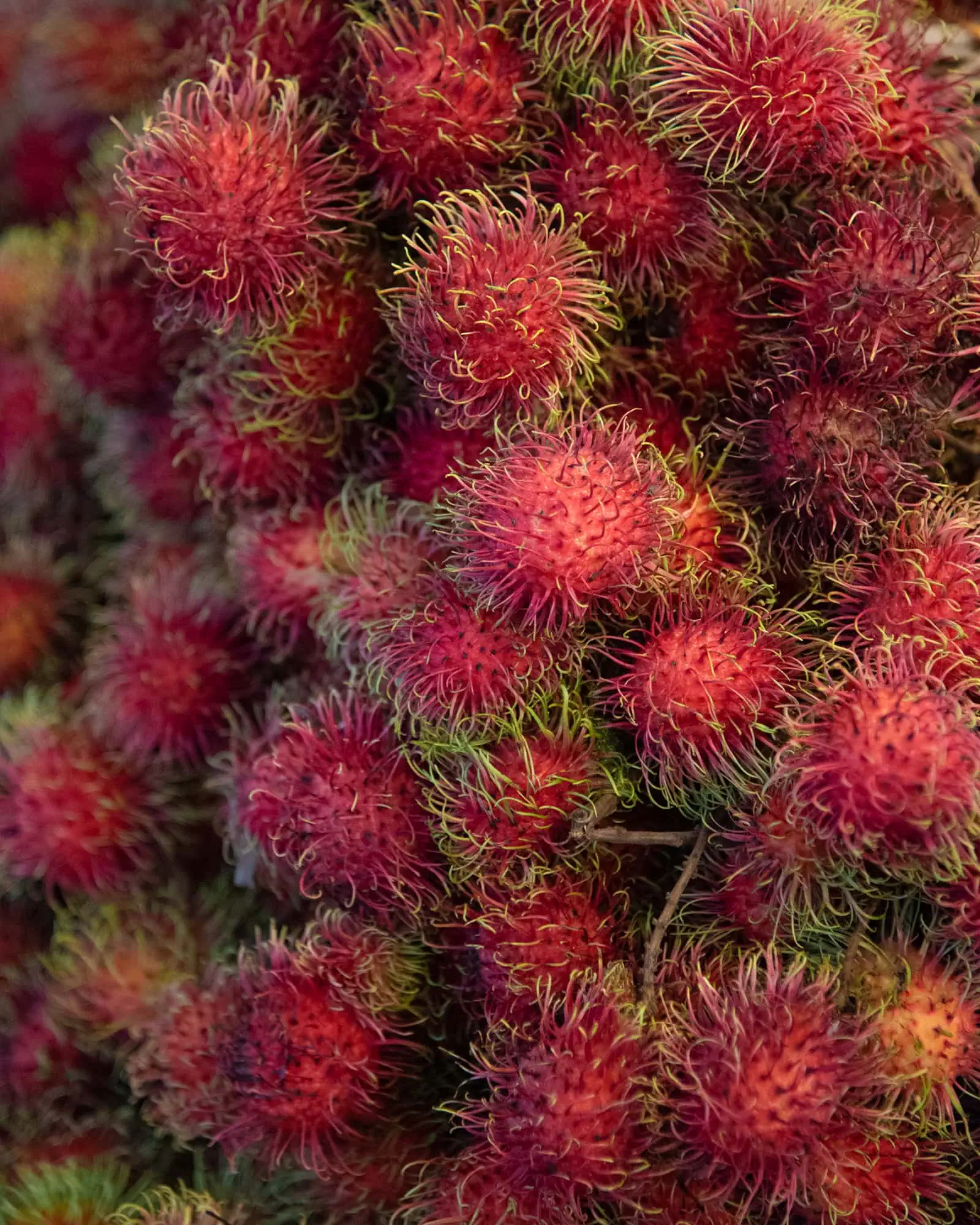
This 1.5km trail (just under a mile) invites you to experience Pulau Ubin with all your senses.
You’ll see, hear, smell, touch, and taste various plants native to the island. Learn how fruit trees like papaya, banana, rambutan, and breadfruit are planted and maintained, as well as spices and herbs. You’ll also learn about their uses and benefits for the local community.
Along the way, you’ll pass by some historical sites, such as an old well, a rubber plantation, and a Malay kampung house.
Wei Tuo Fa Gong Temple
The Wei Tuo Fa Gong Temple is a Chinese temple that is dedicated to Wei Tuo, a Buddhist deity regarded as a guardian of Buddhist monasteries and their teachings.
The temple is located on a hilltop overlooking the sea, is decorated with colorful statues, paintings, and lanterns, and hosts various festivals and ceremonies throughout the year.
German Girl Shrine
This is an interesting shrine that honors a German girl who died on Pulau Ubin during World War I.
According to legend, she was the daughter of a coffee plantation owner who fled from British soldiers and fell off a cliff. Her body was found by some villagers who buried her and built a shrine for her. Over time, she became revered as a deity who grants wishes and protects gamblers.
Puaka Hill
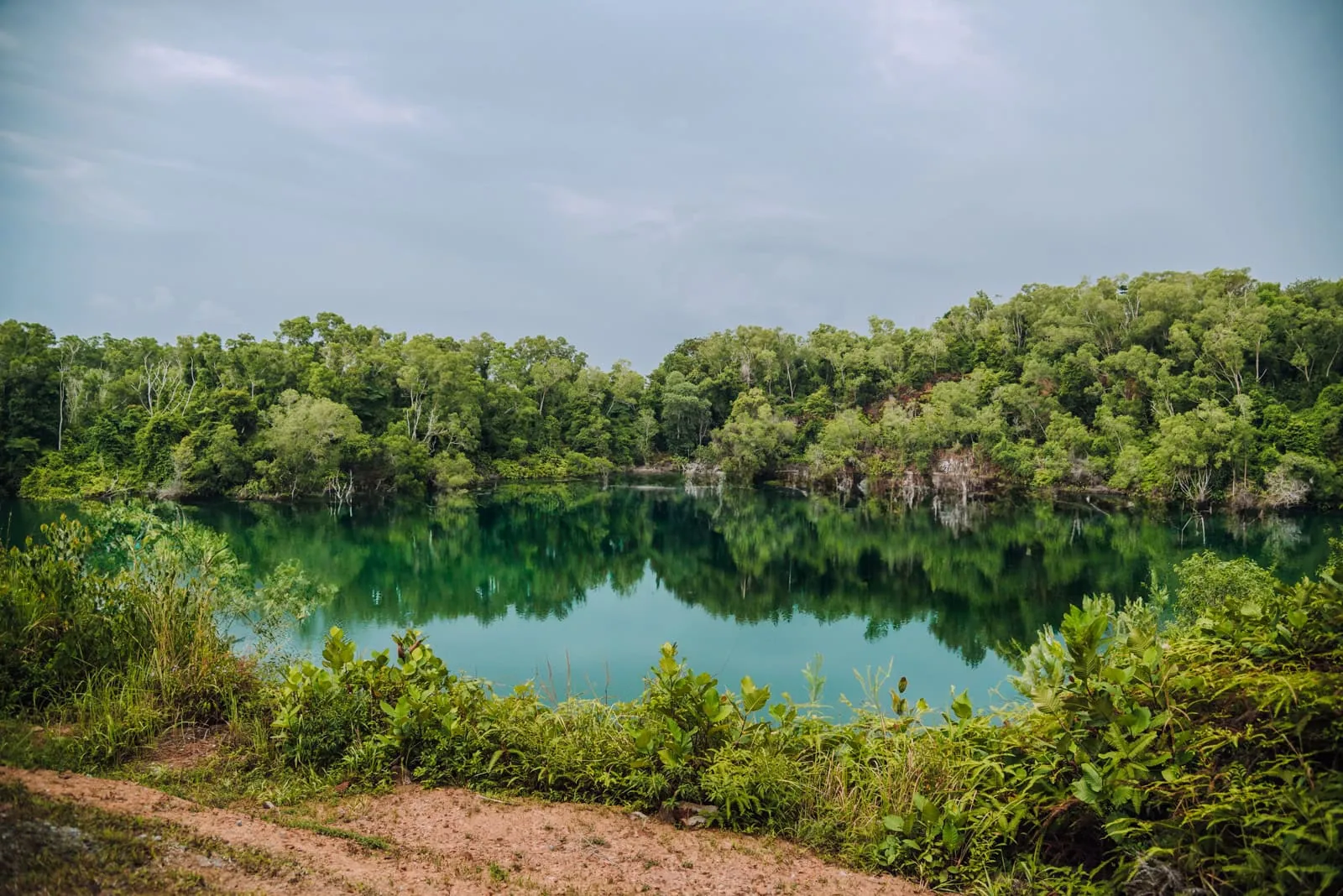
Hike up to Puaka Hill, the highest point on the island, and enjoy a panoramic view of the island and its surroundings. You can also see the remains of an old granite quarry that was once used for building materials.
The roughly 20-minute hike is steep but very rewarding for those who love nature and adventure! It offers views of Ubin Quarry.
Tip: There is a sweet auntie who sells refreshing drinks along Jalan Jelutong, close to the entrance of the Puaka Hill hike! Grab a nice cool coconut after you complete your hike!
Ubin Living Lab
Learn about the island’s history and heritage at the Ubin Living Lab, a former school that has been converted into an education center.
You can see exhibits and displays showcasing the island’s geology, biodiversity, culture, and development. There is a mangrove arboretum and a dedicated space for community wood-working to restore kampung houses.
You can also join workshops and activities that teach you about the island’s crafts, traditions, and values.
Kampung Ubin
Kampung Ubin is one of the last surviving kampongs (villages) in Singapore. On Pulau Ubin, you’ll see traditional houses (no electricity or running water!), explore nature trails, and enjoy the rustic charm of the island. (It’s crazy to think that my mom grew up in a kampong on mainland Singapore when I see the way it is now!)
You can interact with the friendly villagers, learn about their culture and history, and even sample some of their homemade delicacies, such as coconut candy and fried banana fritters. While in the 1960s, around 5,000 people lived on Pulau Ubin, only around 35 villagers live on the island today!
If you want to explore a traditonal kampong house, you can do that on the Kampong Tour on the 3rd Saturday of each month. They’ll take you to Teck Seng’s house, a traditional Chinese kampong house with original architecture that has been converted into an immersive museum. You’ll see what living on Pulau Ubin was like in the 70s!
Wildlife on Pulau Ubin
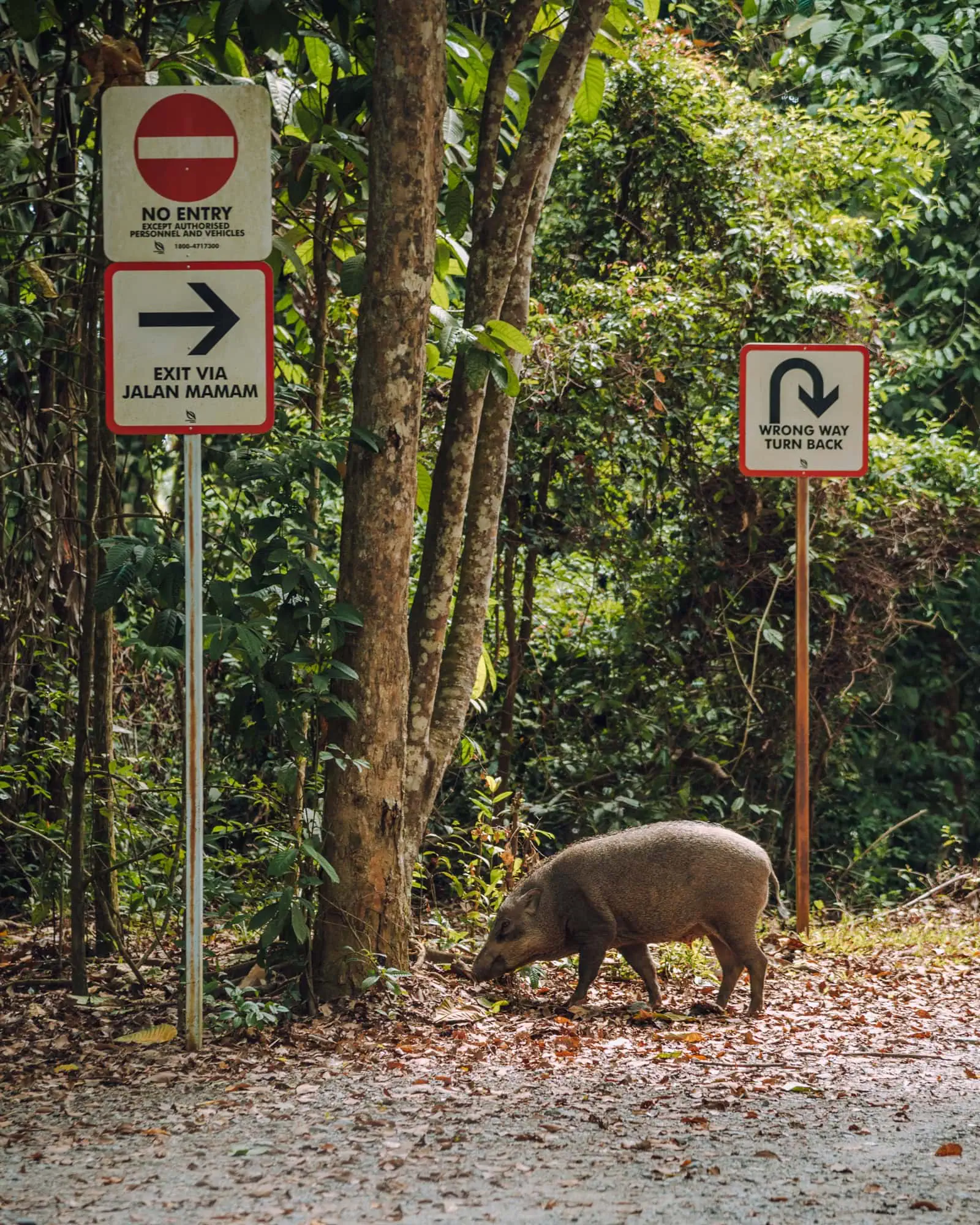
Pulau Ubin is home to many rare and endangered species, such as Oriental Pied Hornbills, smooth-coated otters, and pangolins.
And you’ll almost certainly see long-tailed macaques and wild pigs on the island. Every time I’ve visited Pulau Ubin I’ve seen these mammals.
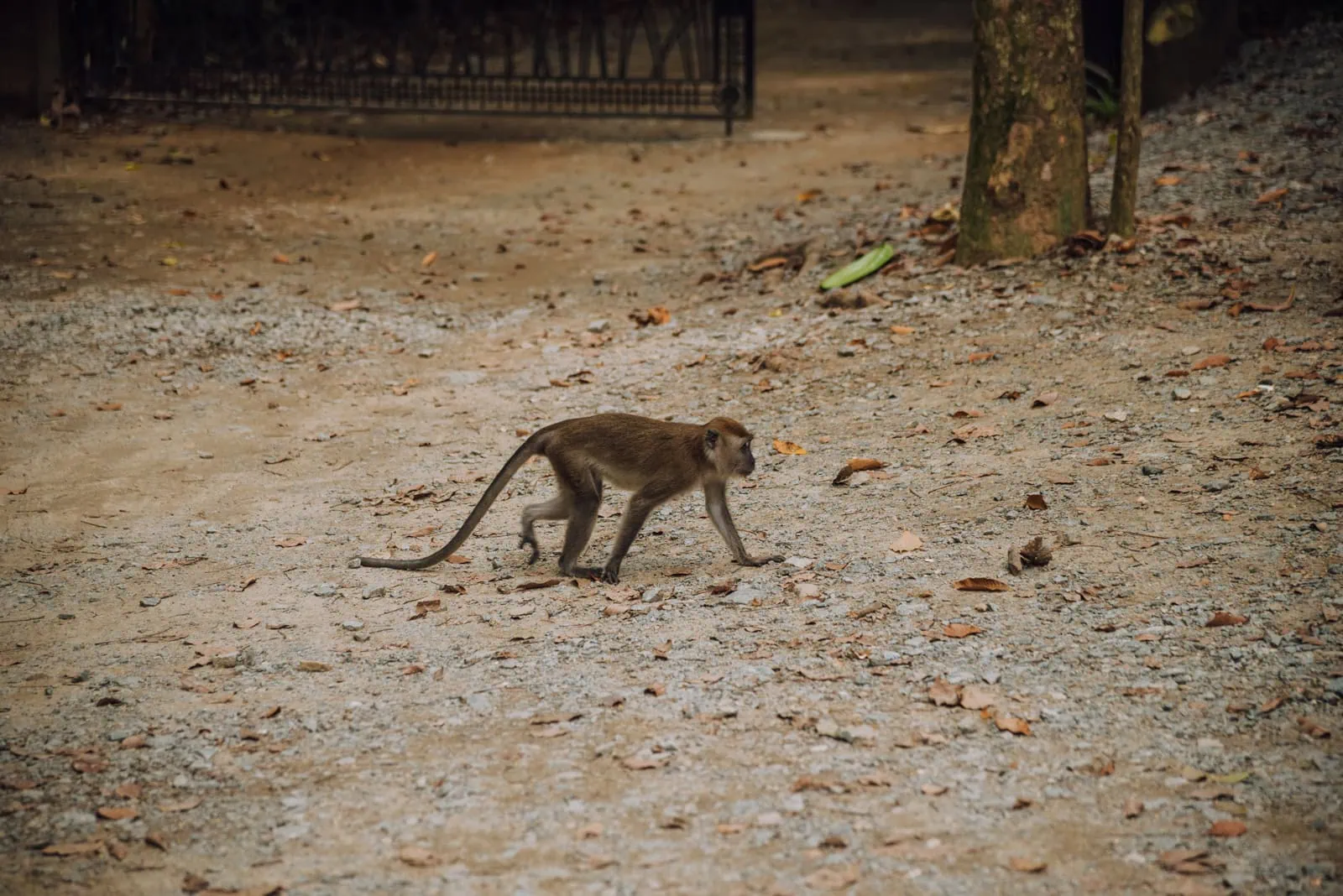
A note on Pulau Ubin monkeys: Frankly, the macaques can be quite intimidating! Make sure you keep water bottles packed away in a backpack because we had some try to steal from us! And don’t bring plastic bags, as they might think you have food and try to attack you. Do not feed the monkeys!
You can also spot colorful butterflies, dragonflies, and birds in the lush forests, or watch crabs, mudskippers, herons, and starfish in the mangroves.
Speaking of marine life, you can actually go fishing at one of the island’s fishing spots, such as Mamam Beach, Jelutong Bridge, or Ubin Jetty. You can catch a variety of fish, such as grouper, barramundi, and parrot fish (depending on your luck and skill!). You can even cook your catch at one of the barbecue pits on the island!
Camping Overnight on Pulau Ubin
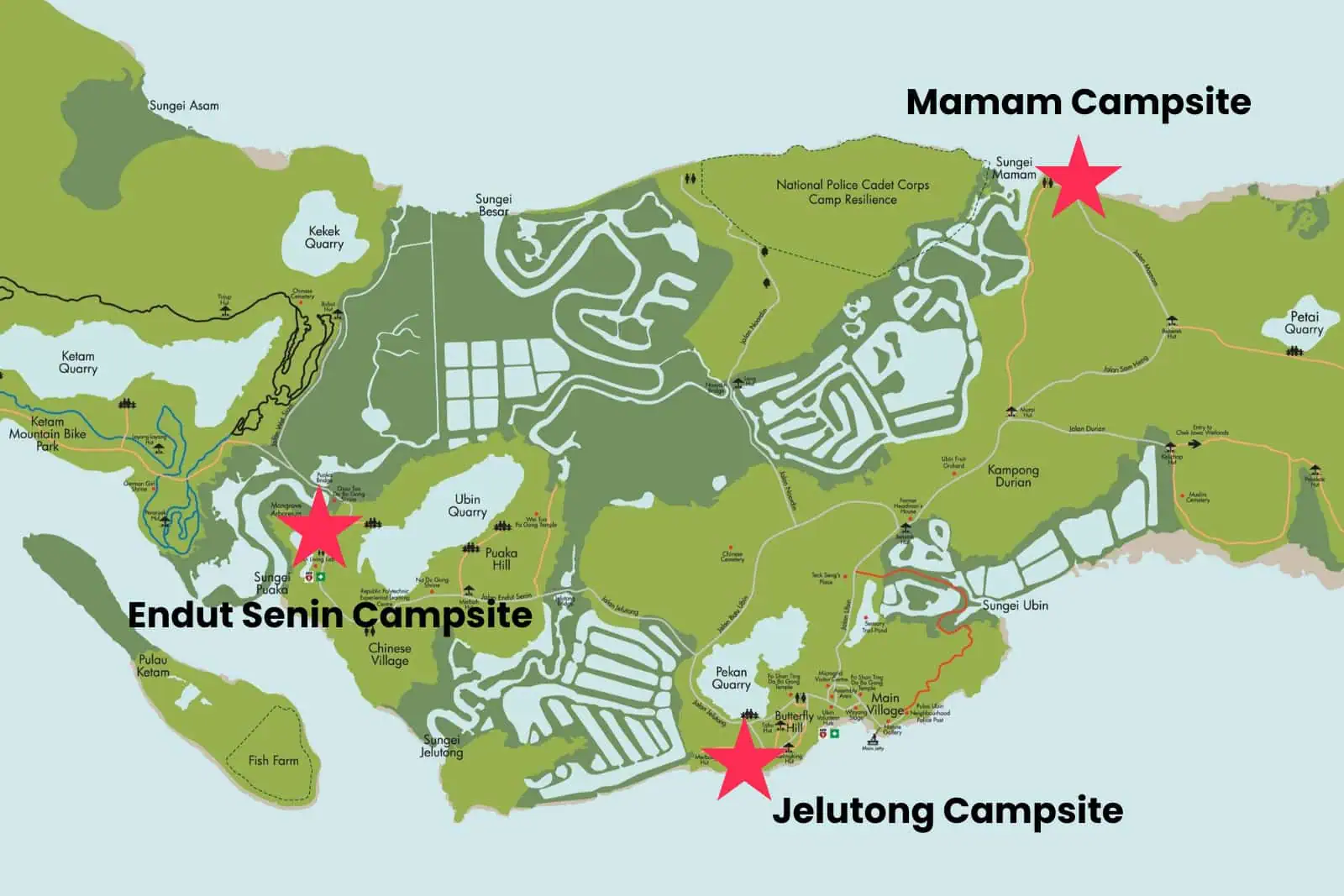
Pulau Ubin is also a great place for camping! You can camp at one of three designated camping sites: Jelutong Campsite, located closest to Main Village with views of the mainland, Mamam, located on the northern part of the island, or Endut Senin, located out west by the Ubin Living Lab and Ubin Quarry.
Here are some tips on how to camp overnight at Pulau Ubin:
Book your campsite in advance.
Apply for a camping permit at least two weeks in advance. There are three designated campsites on the island: Jelutong, Endut Senin, and Mamam. You can book them online or at the information kiosk near the jetty. You’ll want to check in at the Pulau Ubin Police Post when you arrive on the island to register your stay. The campsites have basic facilities such as campfires and toilets nearby.
Pack light and bring essentials.
You will need to take a boat from Changi Point Ferry Terminal to Pulau Ubin, and then walk or cycle to your campsite. So pack light and bring only the essentials, such as a tent, sleeping bag, flashlight, insect repellent, wet wipes, food/snacks, and water. Tents and cooking utensils are available to rent at various campsites on the island if you don’t have your own!
Bring cash!
You will need cash to buy water and food from kiosks, and rent bicycles and potentially camping equipment, and there are no ATMs, so be prepared!
Arrive during daylight.
You don’t want to be setting up your tent in the dark! Arriving in daylight also means you are aware of the shoreline- depending on the campsite, you may be close to the water, and you don’t want to pitch your tent in the dark and wake up soaking wet when the tide comes in!
Respect the environment and the locals.
Pulau Ubin is a natural reserve and a home to many animals and plants. Please do not litter, make noise, or disturb the wildlife. Be aware that there are wild boar on the island, so don’t leave anything outside your tent that you’re not happy to let a pig snuffle through (especially food)! Also, be respectful of the local villagers who live on the island. They are friendly and helpful, but they also value their privacy and culture.
Pulau Ubin FAQ
Here are some common questions you might have before heading to Pulau Ubin that I haven’t covered yet!
Can you swim at Pulau Ubin?
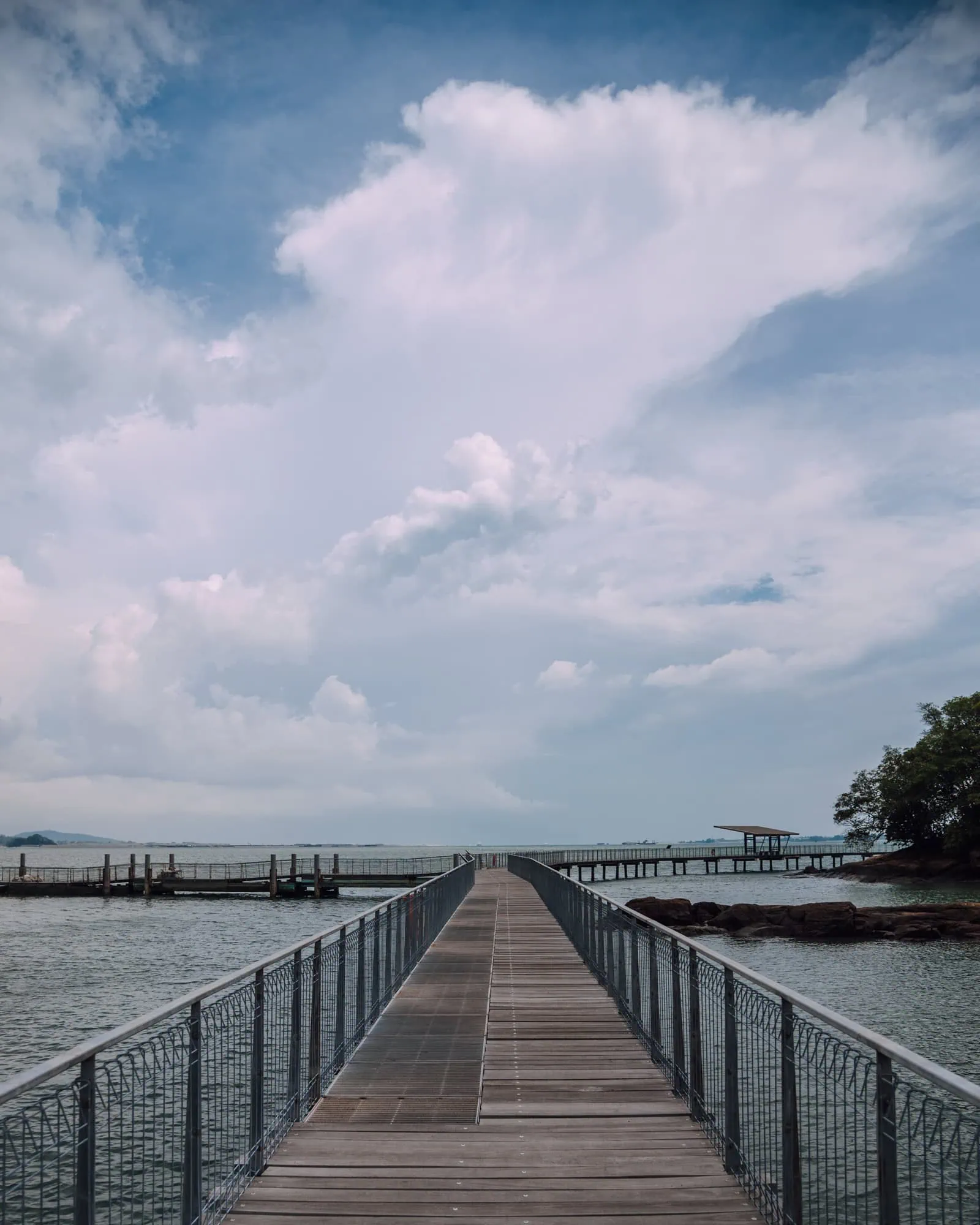
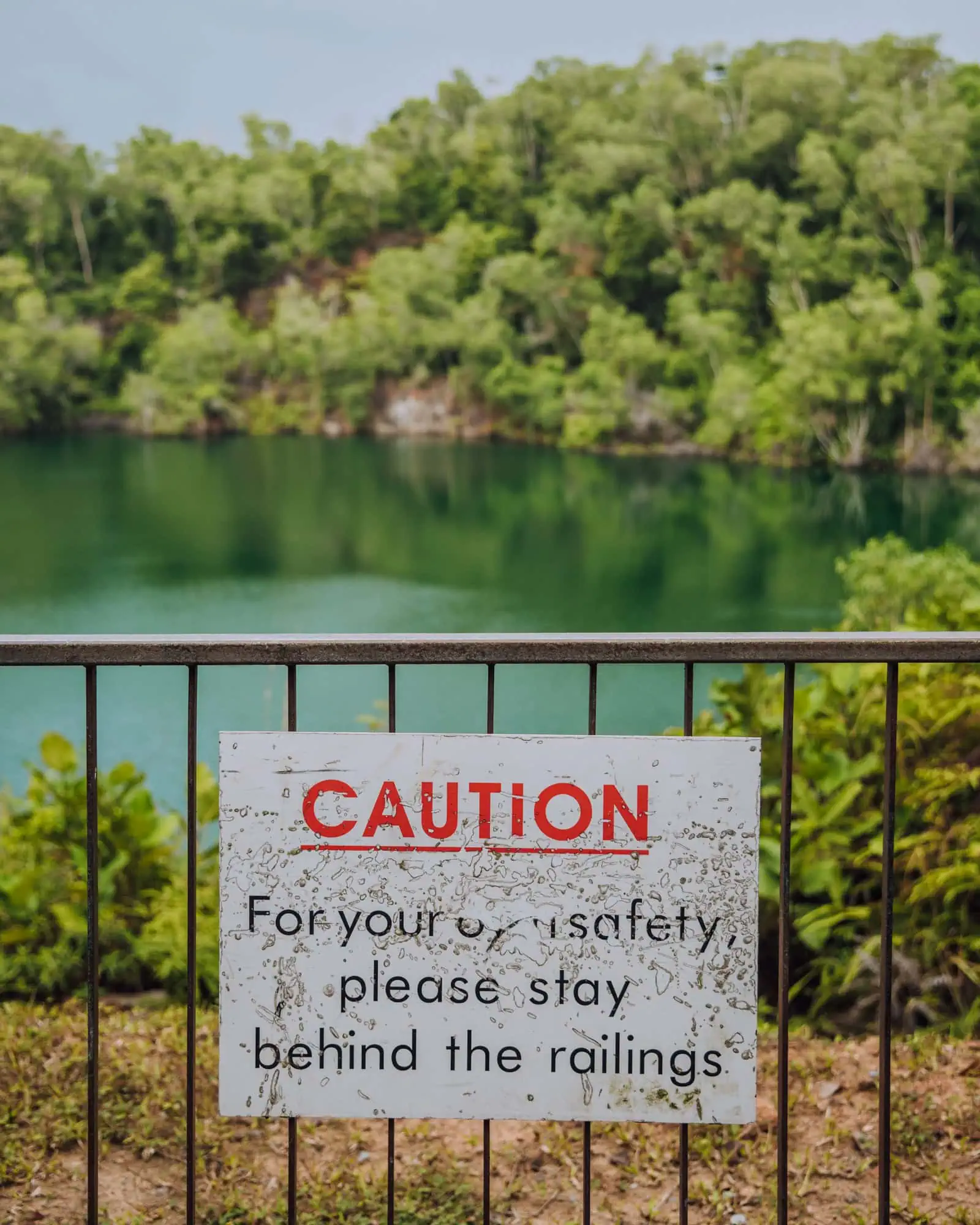
I had to include this section because when you think of an island in Southeast Asia, it’s common to think of sandy beaches and beautiful waters for swimming. Ubin Island is definitely not that… you won’t find swimming areas on this island!
If you want to swim in Singapore, I recommend heading to Sentosa instead!
Is Pulau Ubin kid-friendly?
Pulau Ubin is definitely kid-friendly! What a great environment to let kids learn in and explore!
Some of the bike rental shops have tricycles and bikes with side carts for babies that you can rent.
If you’re traveling with a baby, I recommend bringing a baby carrier so that you can wear your baby while walking around. I use (and love!) this cloth carrier for younger babies and this more heavy-duty carrier for older babies/toddlers.
What should you pack for Pulau Ubin?
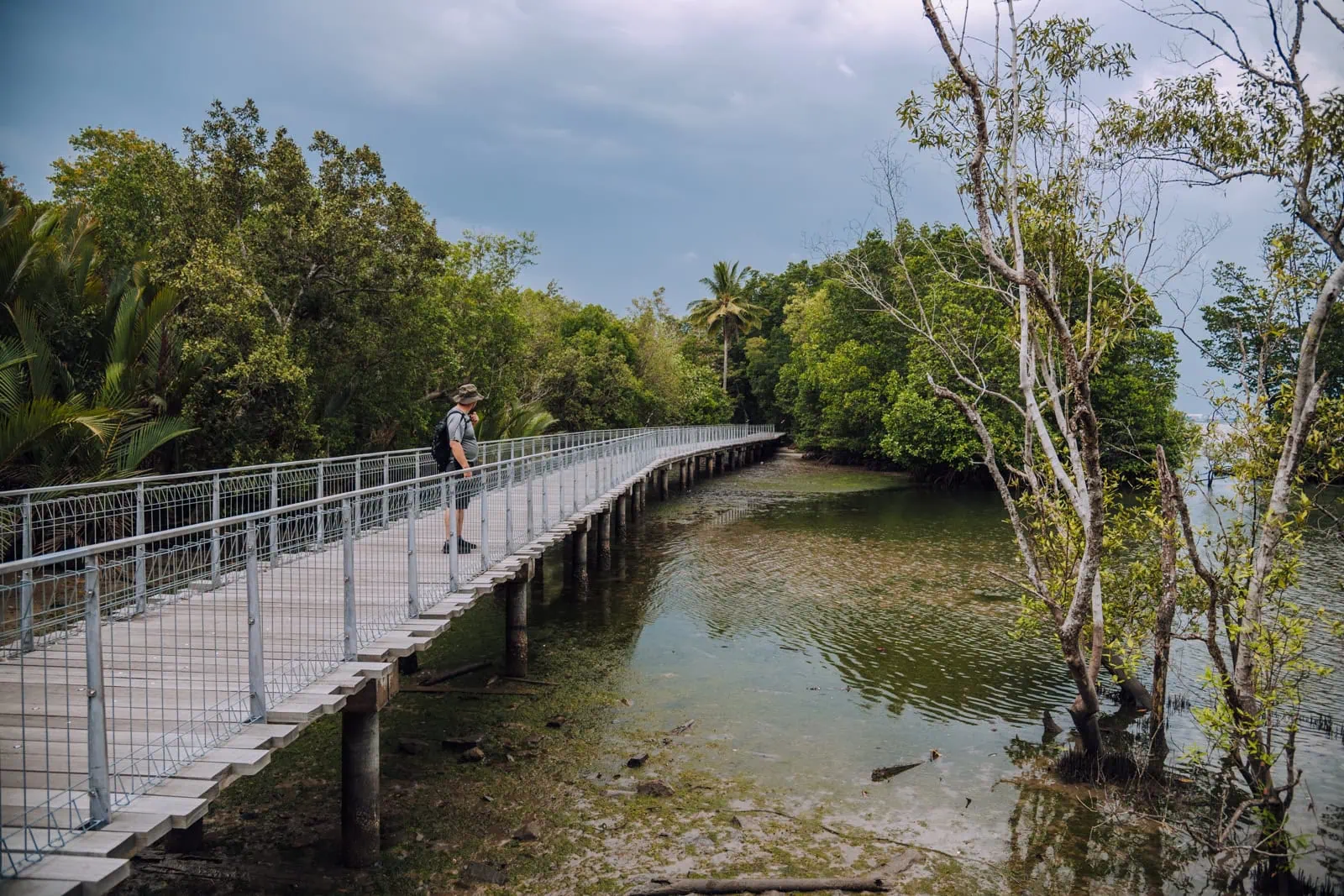
Here’s what you should pack for Pulau Ubin:
- Money: at a minimum, you’ll need S$8 per person for the bumboat ride and S$8-20 for bicycle rentals. So that brings us to S$28 cash per person, minimum.
- Insect repellent: You’ll need some bug spray to protect you from bug bites on this very rural island.
- Water: while you can buy water bottles on the island, you can save money by bringing your own. Note that the water on the island is not potable, unlike on mainland Singapore.
- Sunblock: since you’ll be outside all day! A lot of the island is shaded, but there are some places where you’ll be in direct sunlight.
- Camera: from the wildlife to the unique ecosystems, the island is incredibly photo-worthy!
- Umbrella or poncho: in case you get caught in the rain!
- Tissues/napkins: you’ll want these when eating at one of the local restaurants!
- Portable phone charger: make sure you have enough battery to last a full day on the island.
Where is the best place to watch the sunset on Pulau Ubin?
Pekan Quarry is a popular place to watch the sunset, as it’s just a 15 minute walk from the main jetty. Just keep in mind that the last bumboat departs at 7pm! So if if you’re not camping overnight, then you’ll need to arrange a late pick up with a bumboat driver. Keep in mind the driver might charge you an extra fee for that, which you can negotiate.
In conclusion…
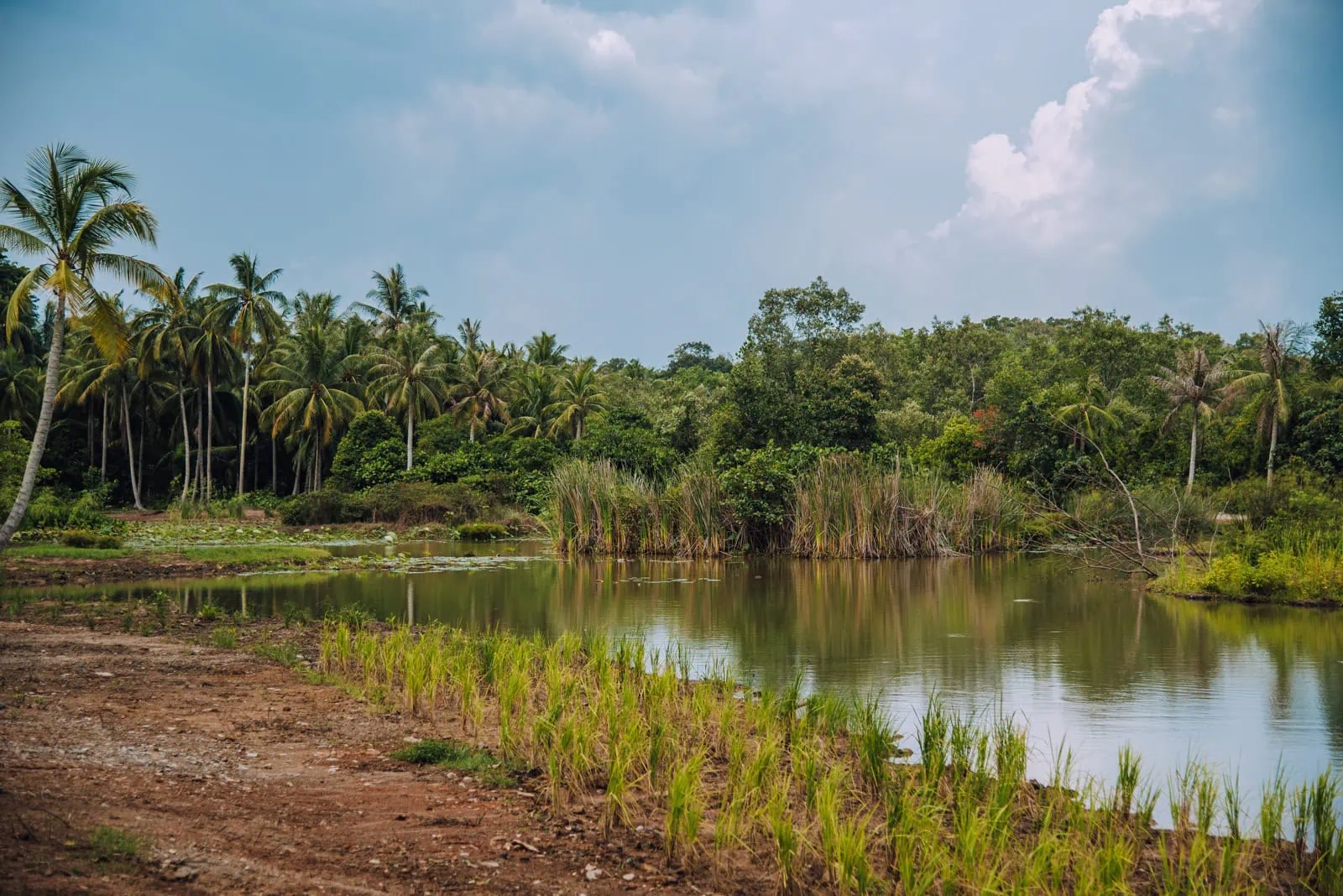
There are just so many things that you can do on Pulau Ubin- kayaking, fishing, exploring, or simply relaxing on the beach! No matter what you choose to do, you won’t forget this island paradise in a hurry.
Pulau Ubin is a treasure trove of nature and culture that will make you feel like you’ve traveled back in time. It’s a must-visit for nature lovers or for anyone who wants a quiet break. Don’t miss this opportunity to discover one of Singapore’s last rural areas and experience its simple joys!
And while you’re in Singapore, here are a couple more posts you might enjoy!
- The Most Instagrammable Places in Singapore
- Top Things You Absolutely Must Do in Singapore
- 15 Things You Need to Know Before Visiting Singapore
Happy exploring!
Jasmine
